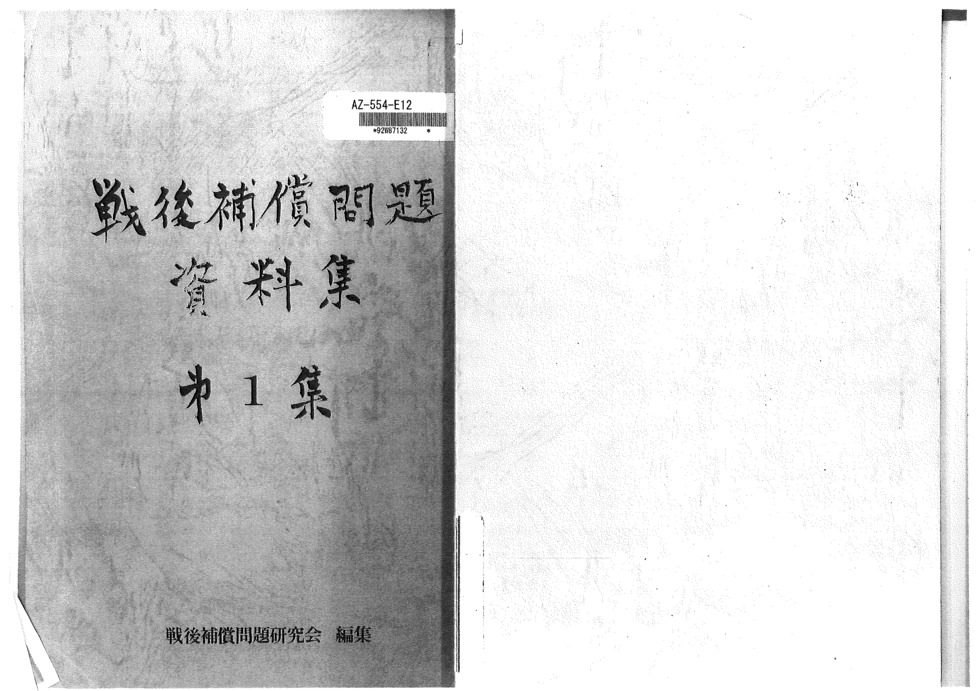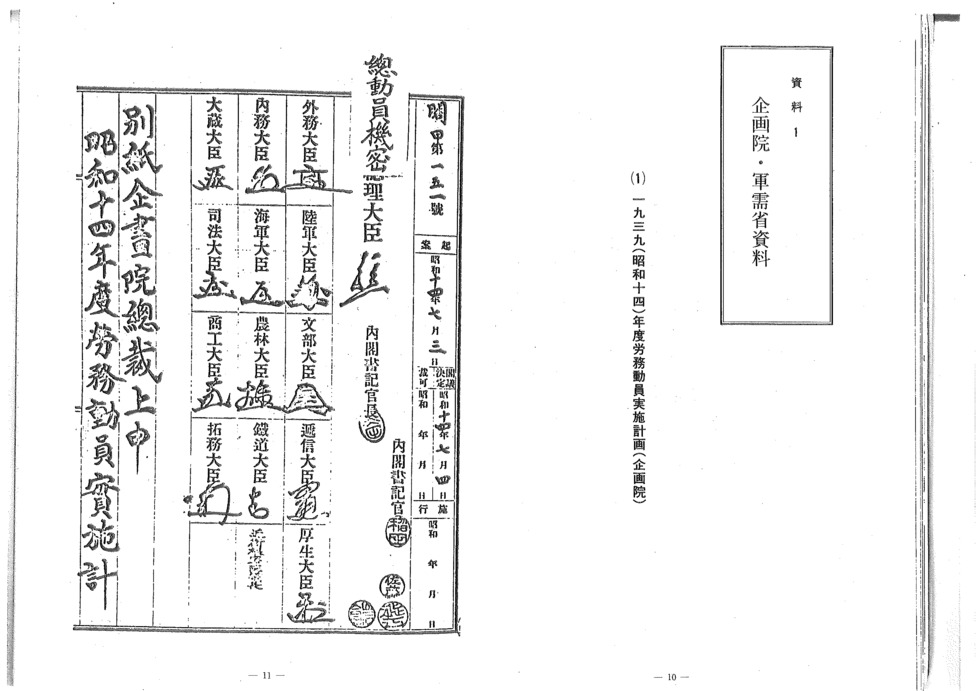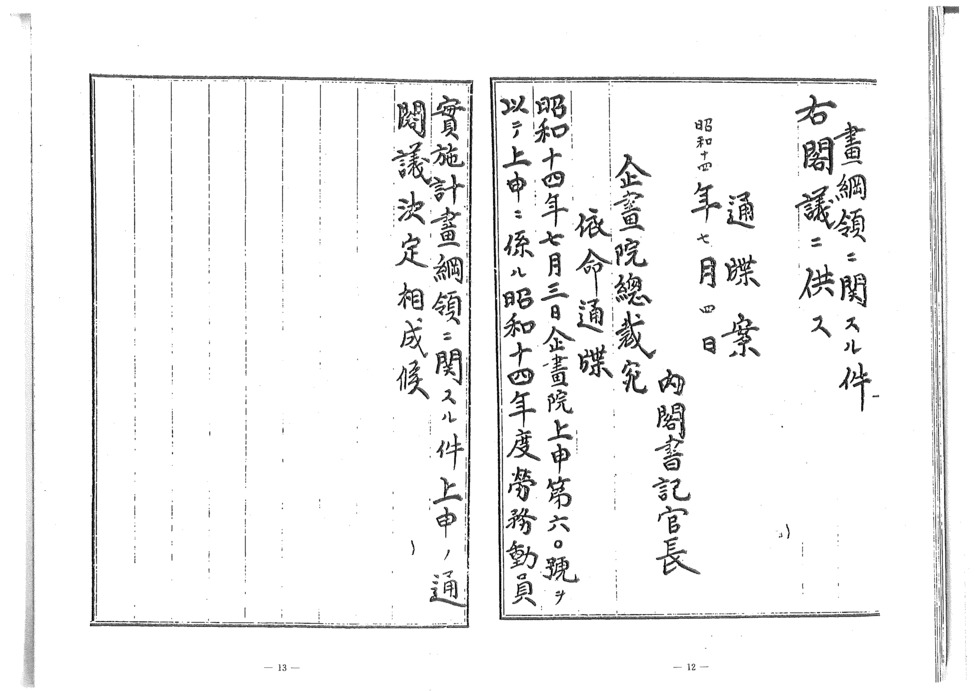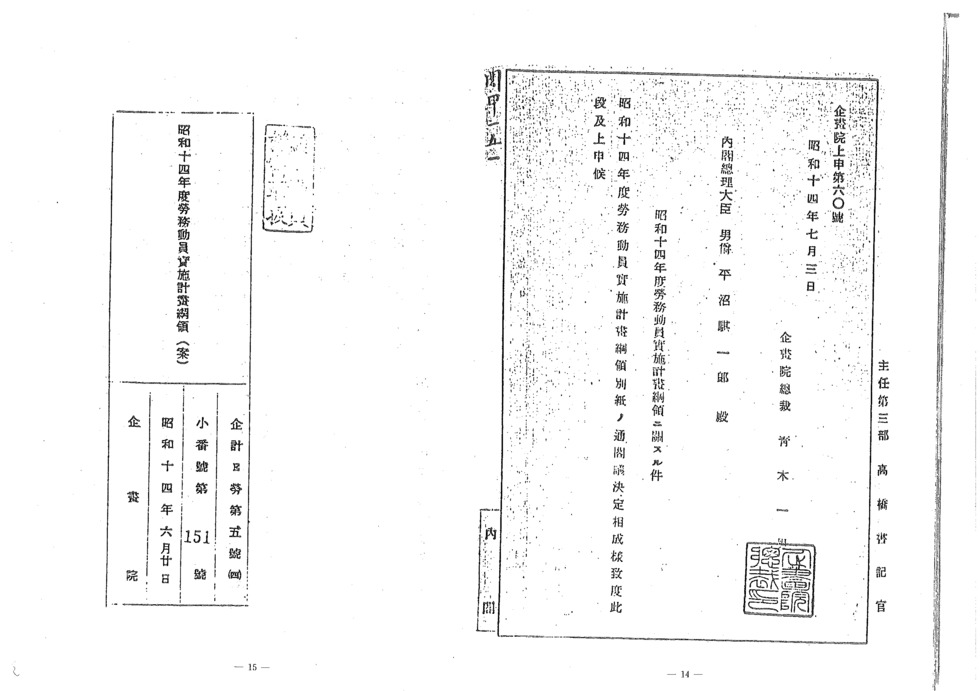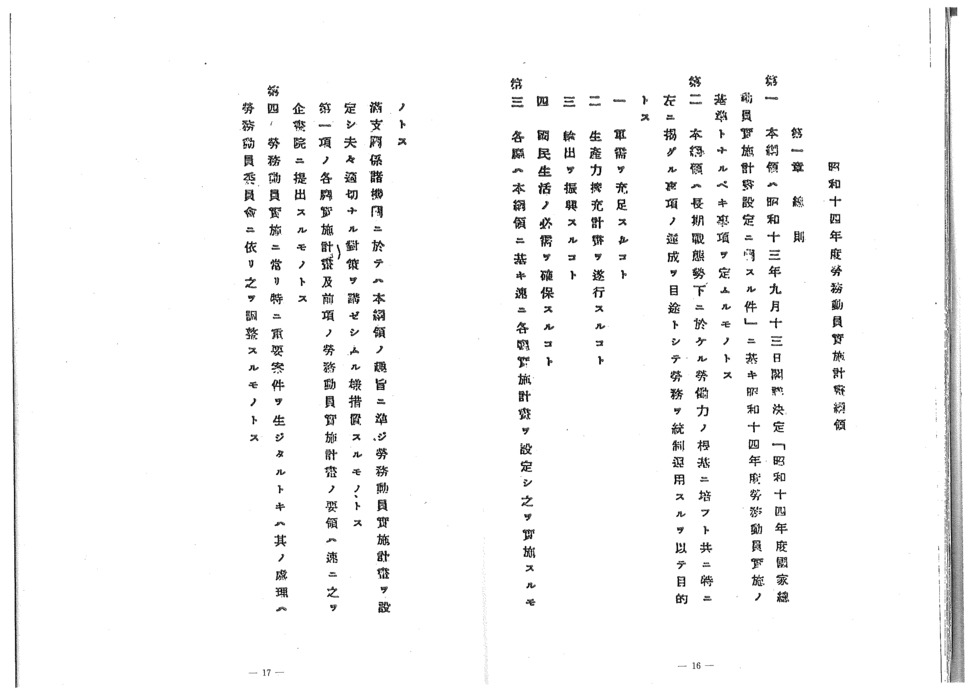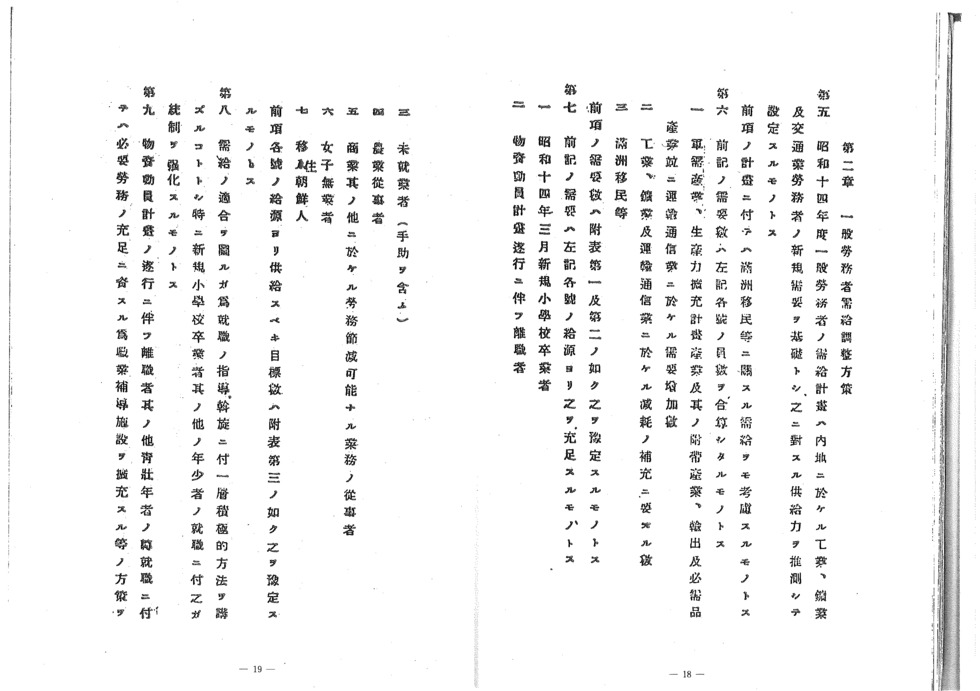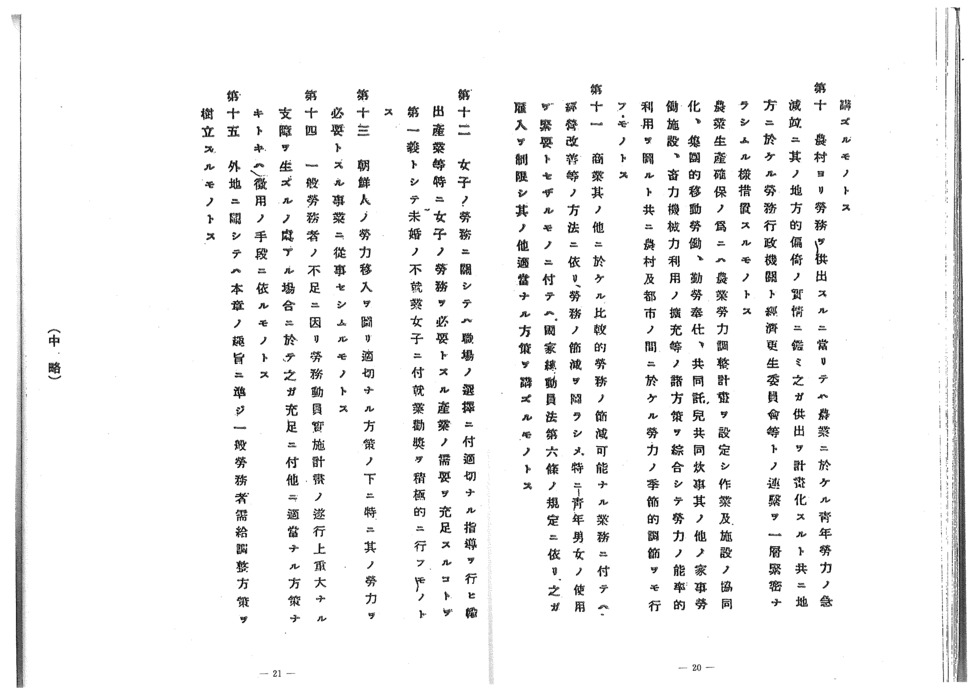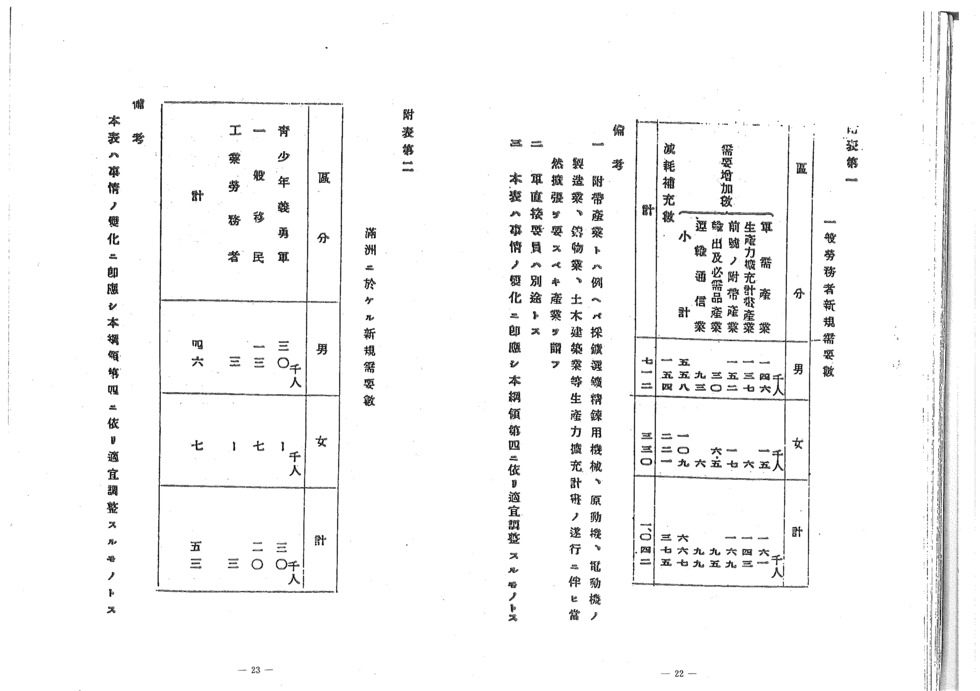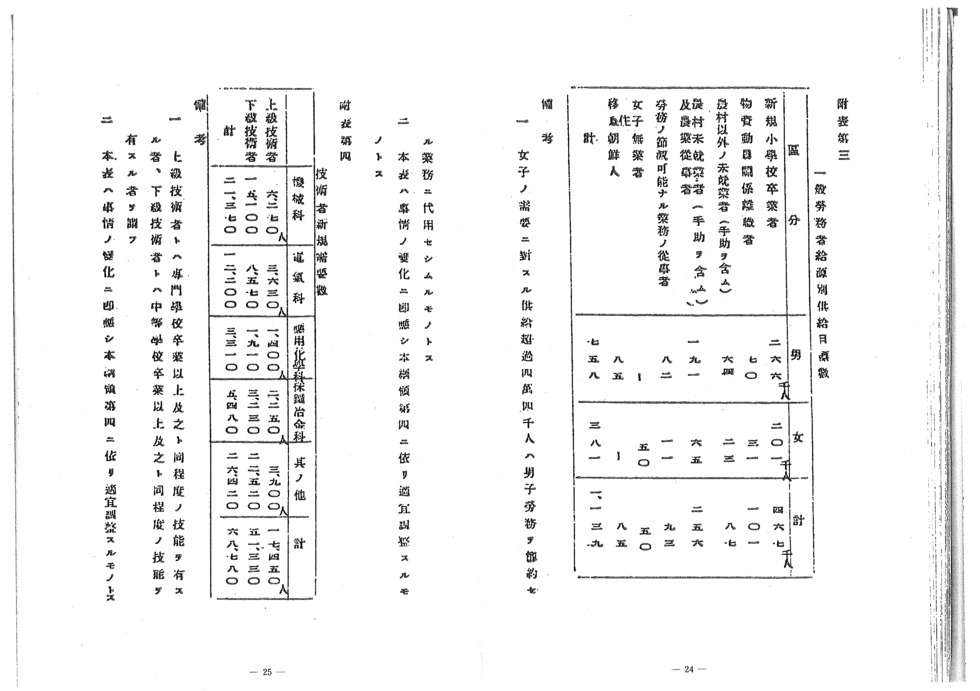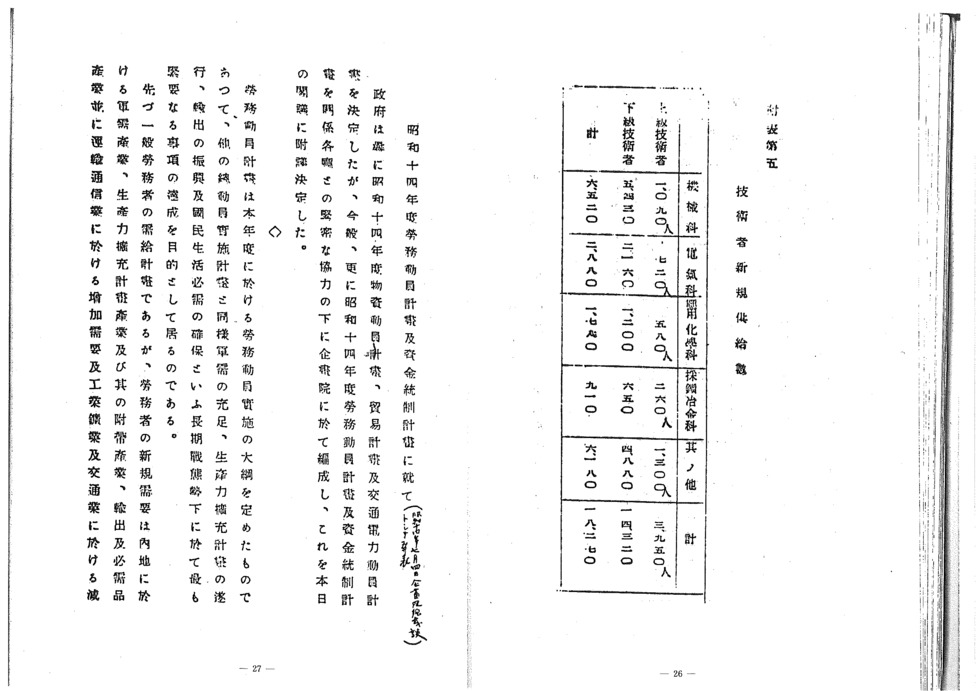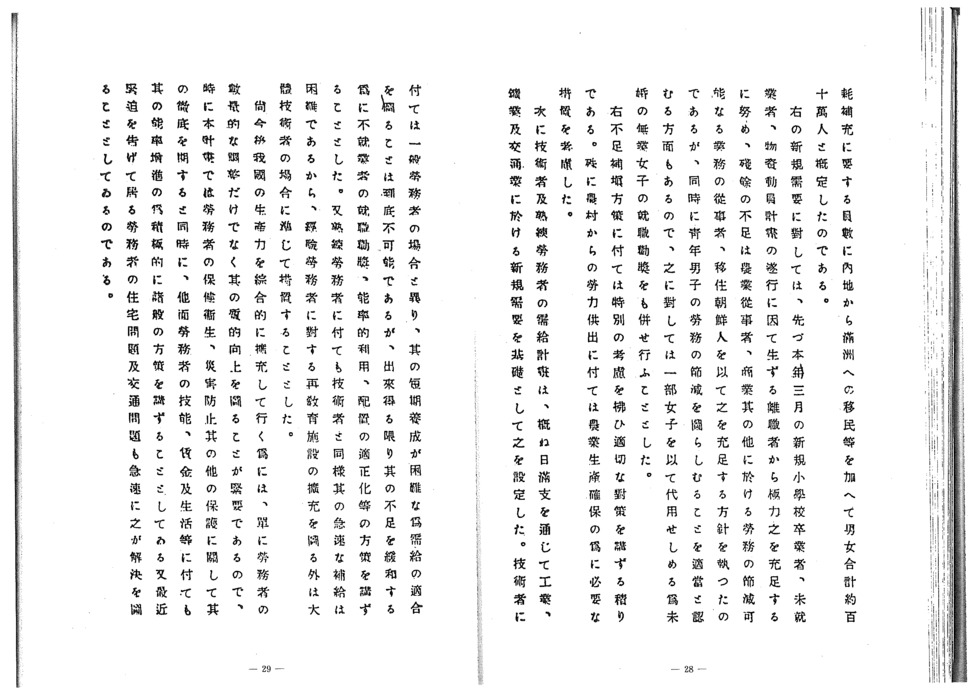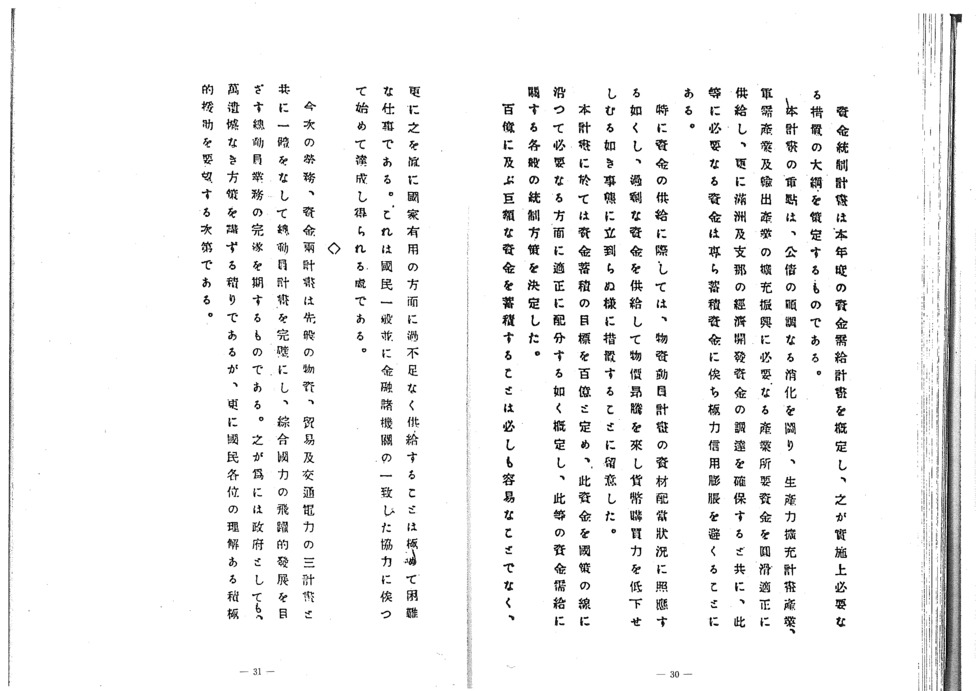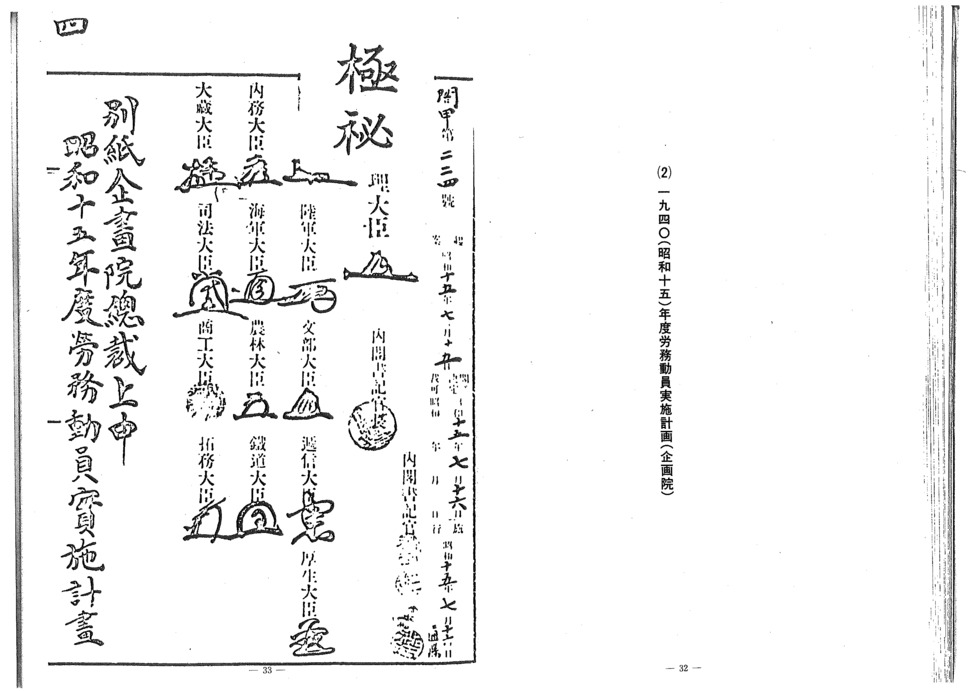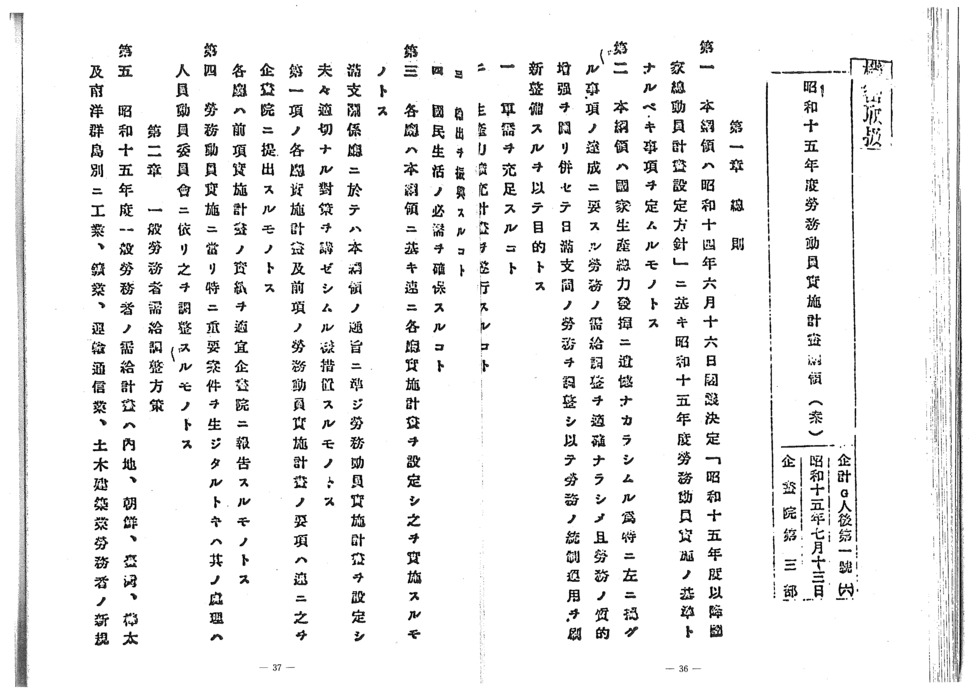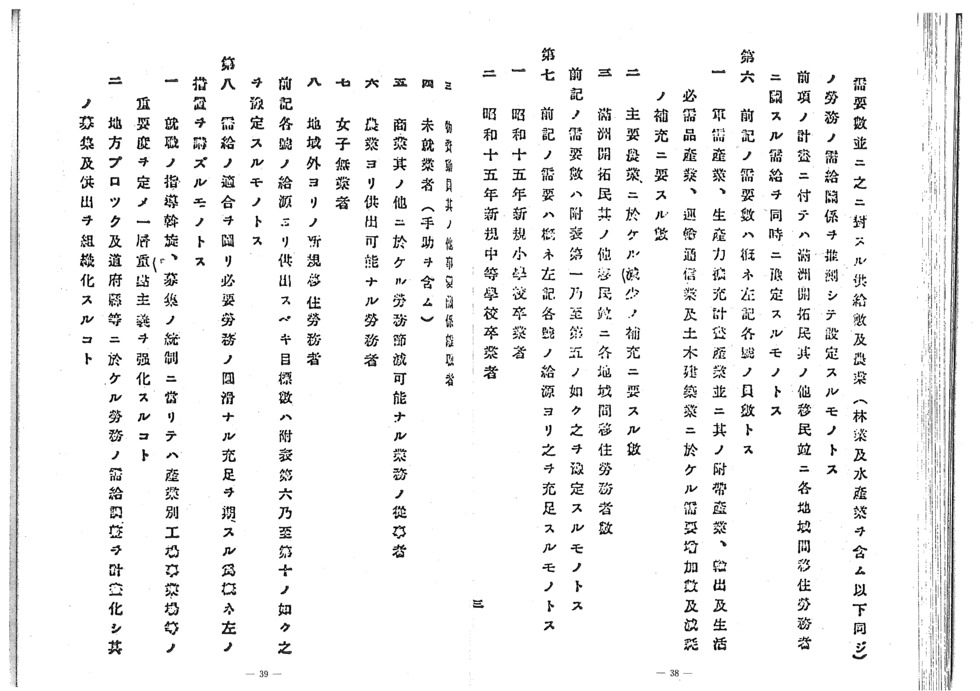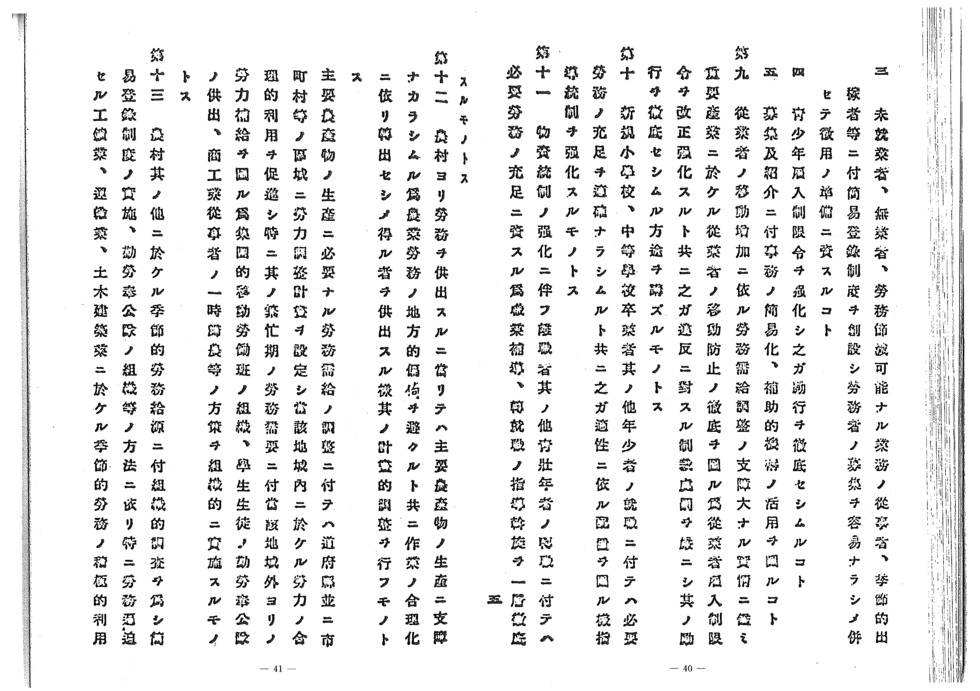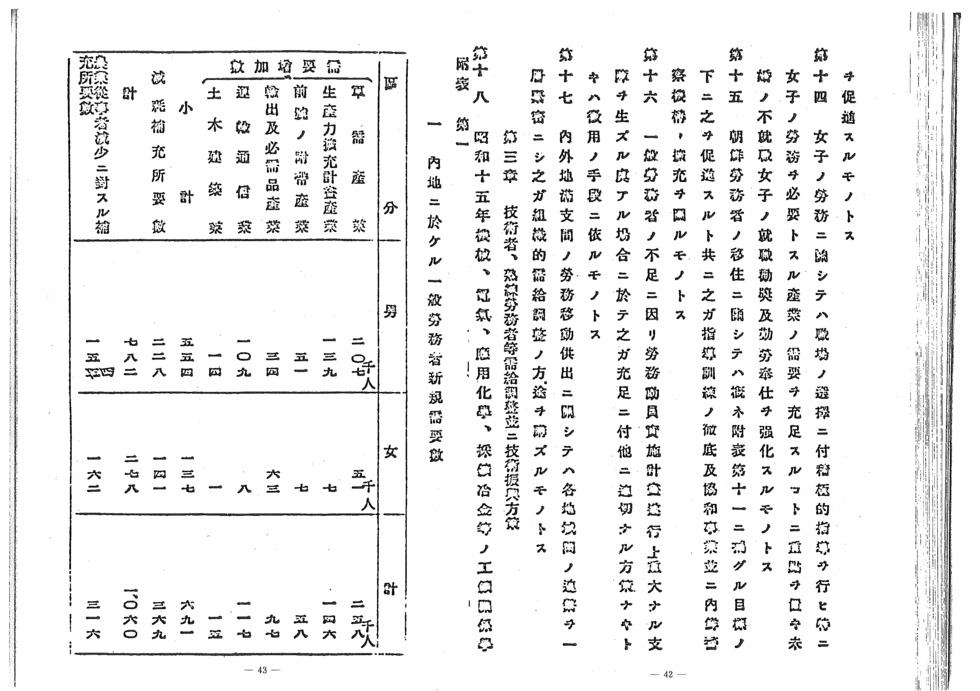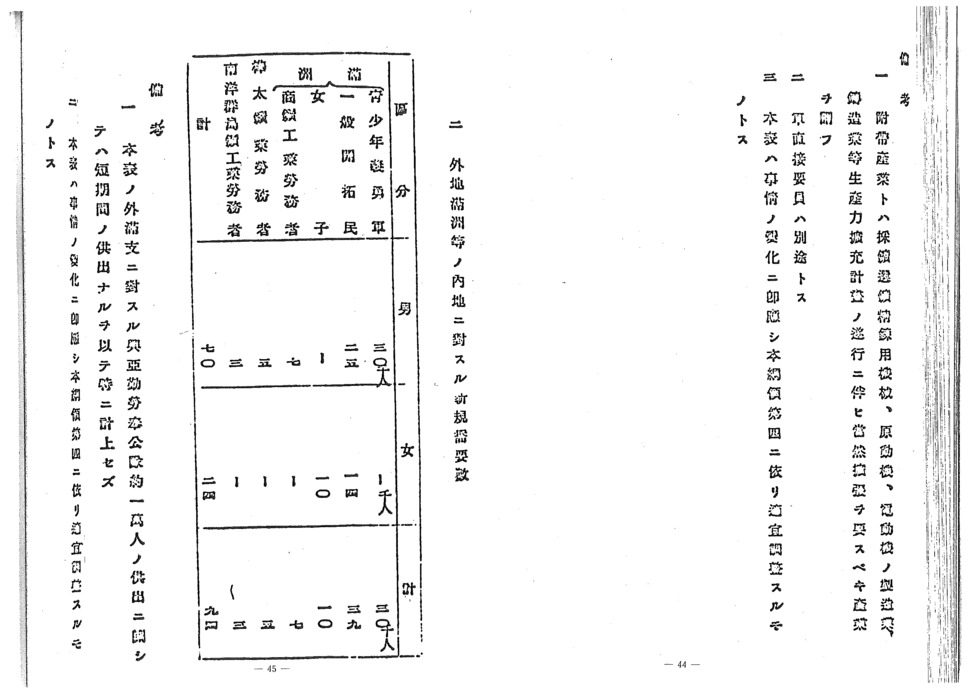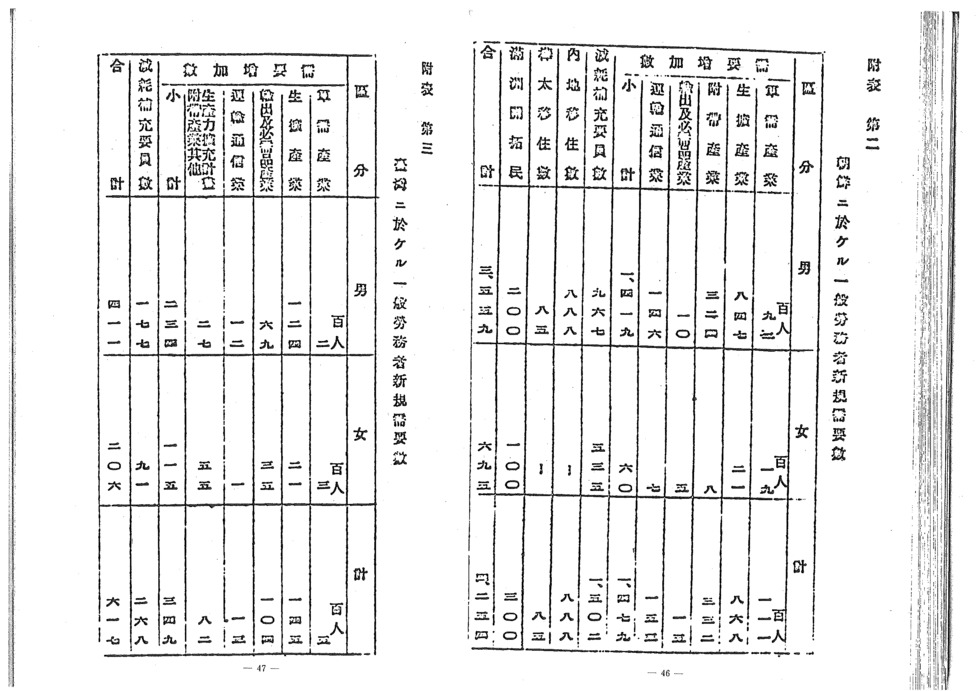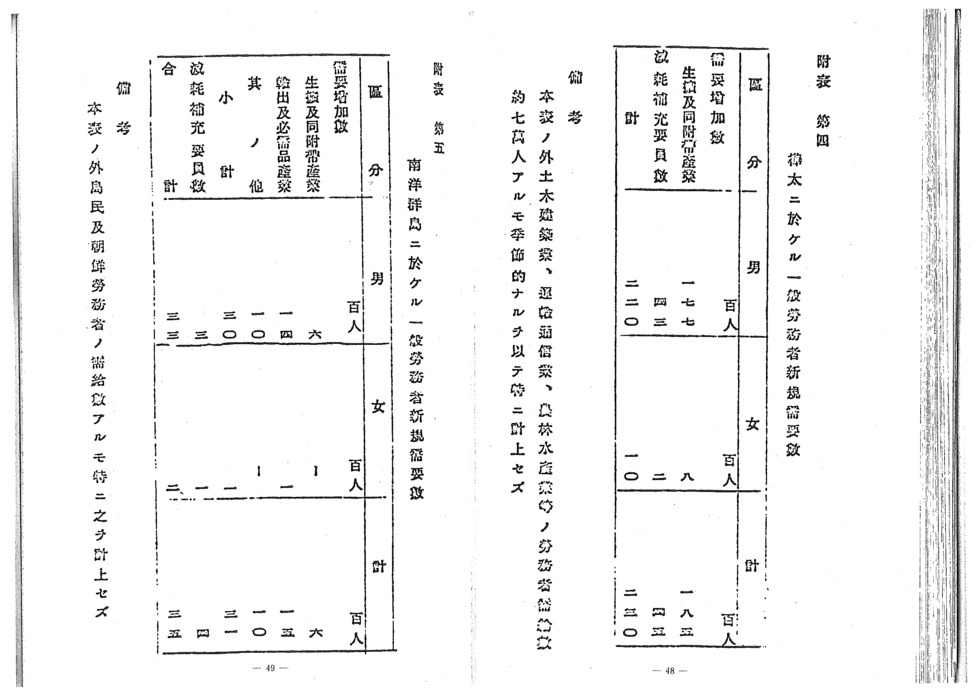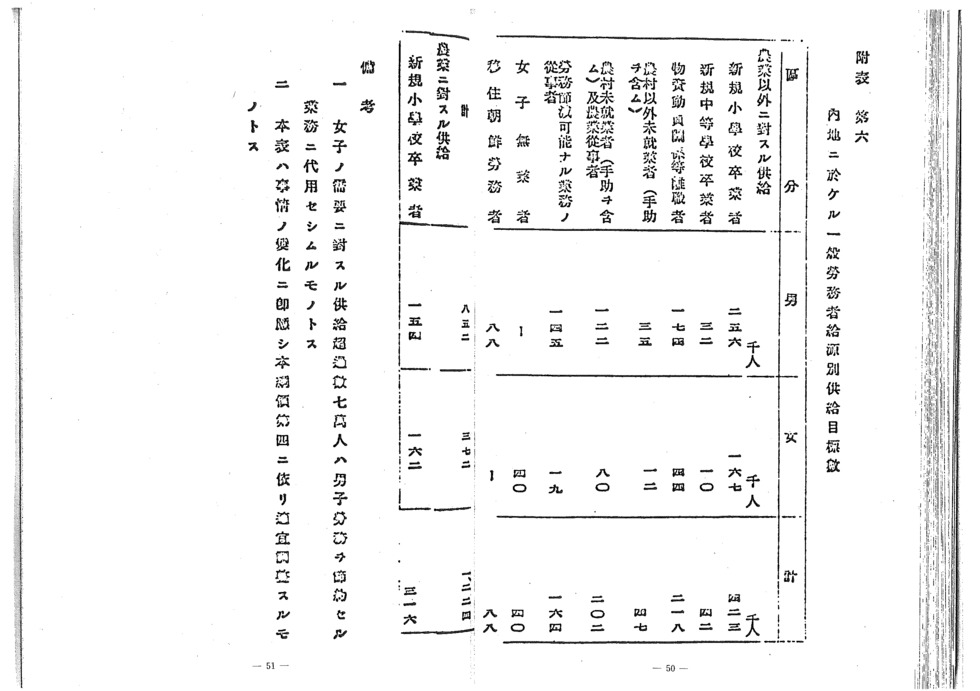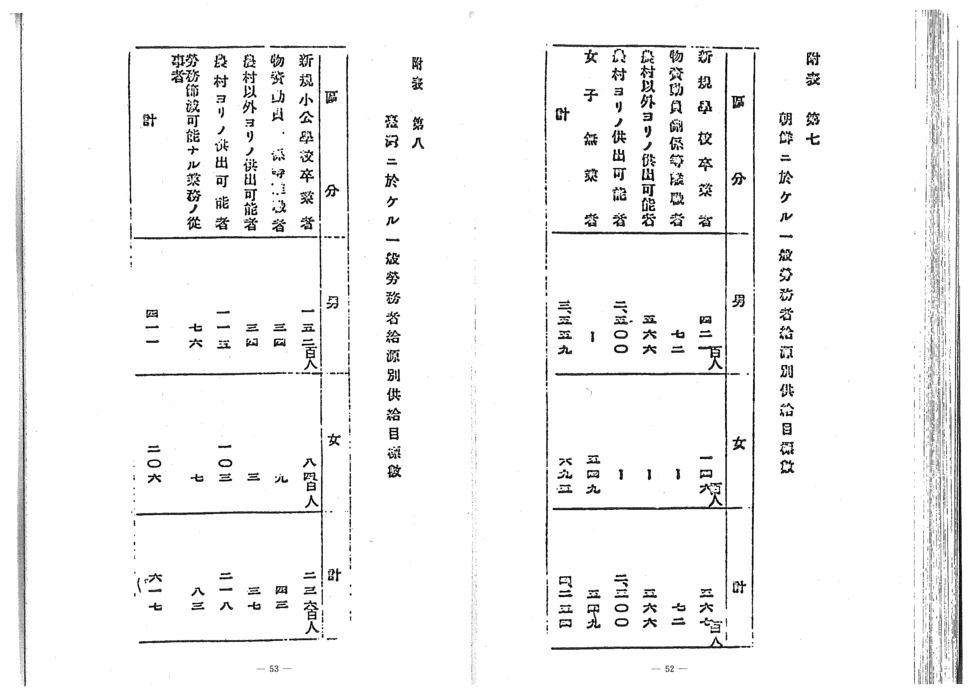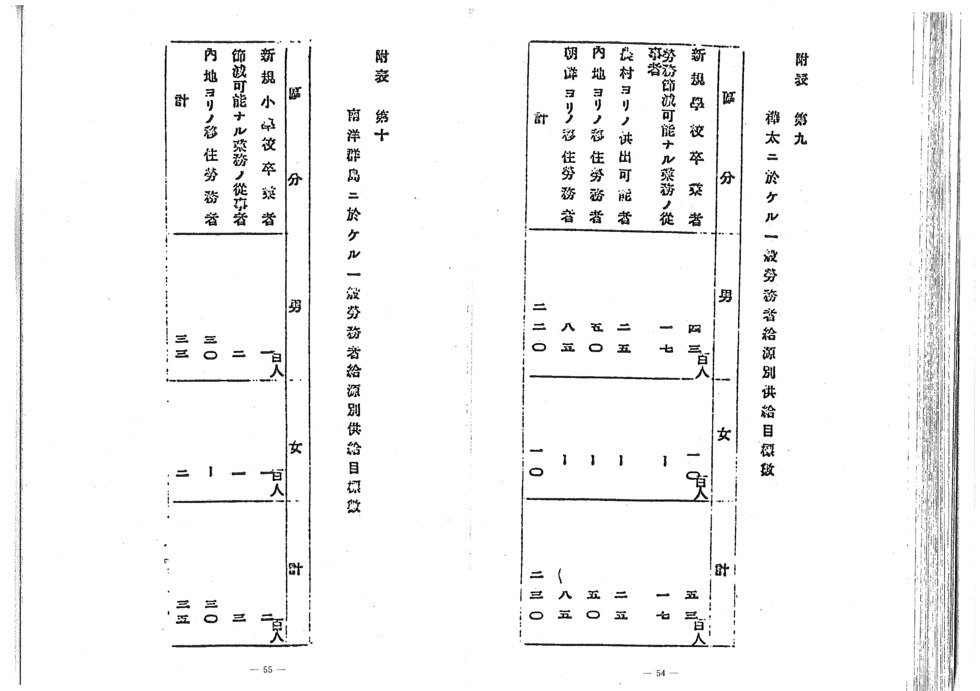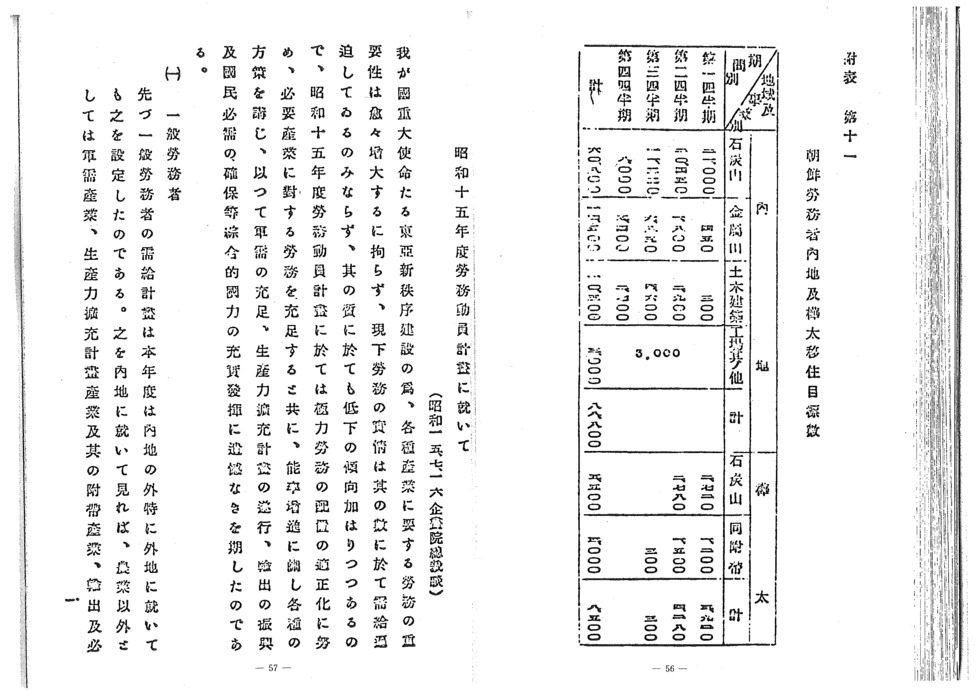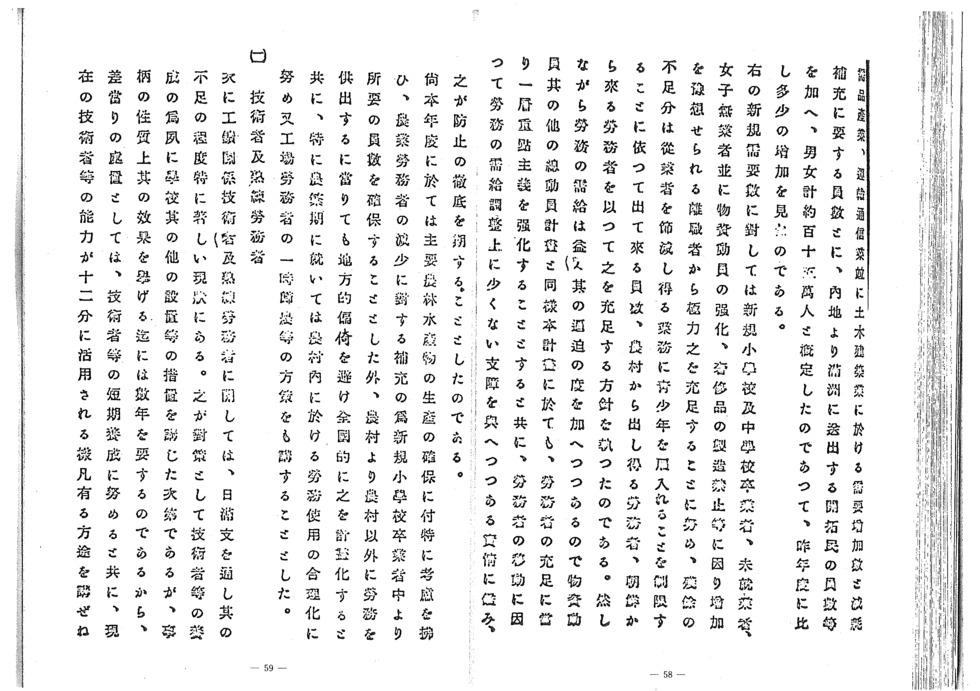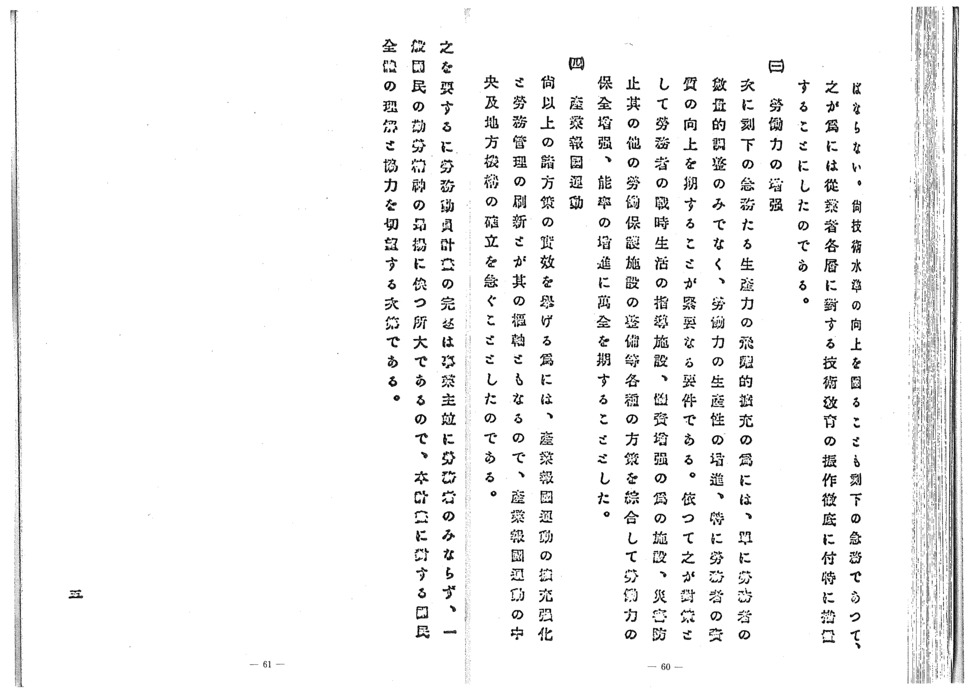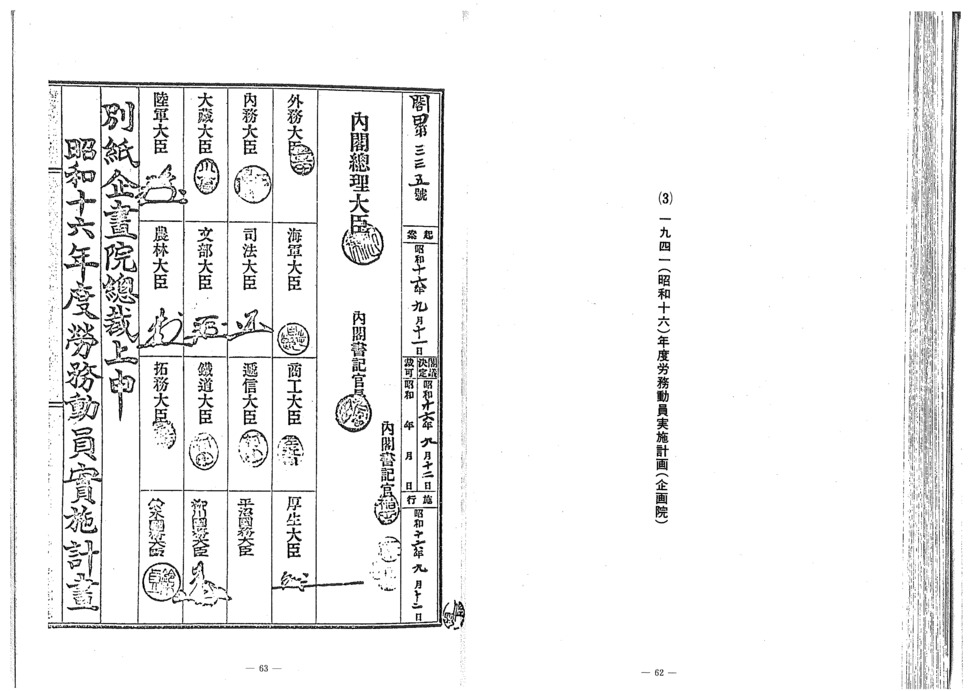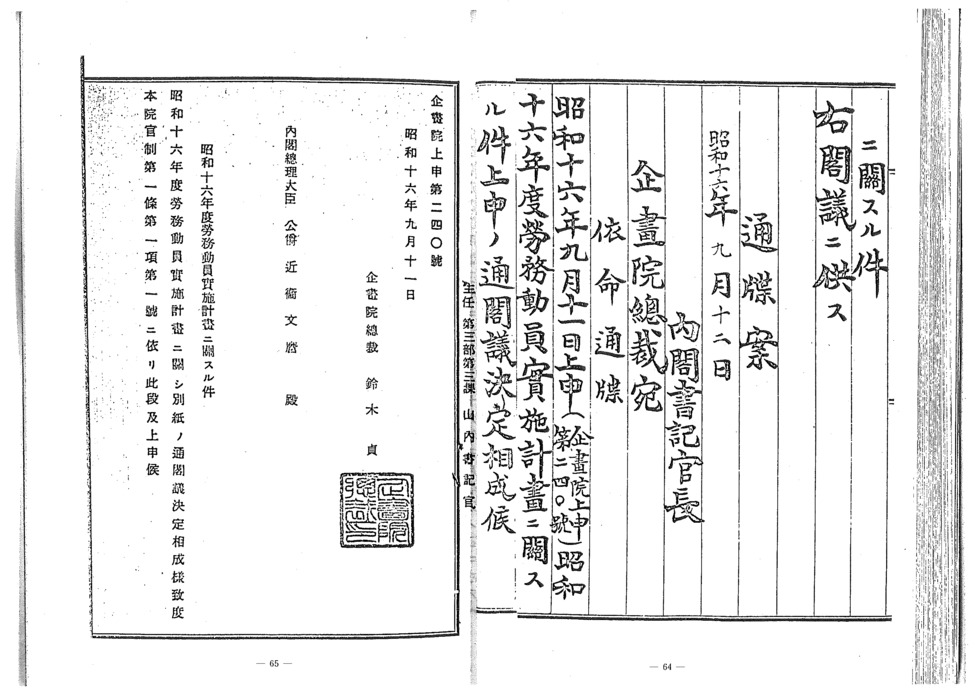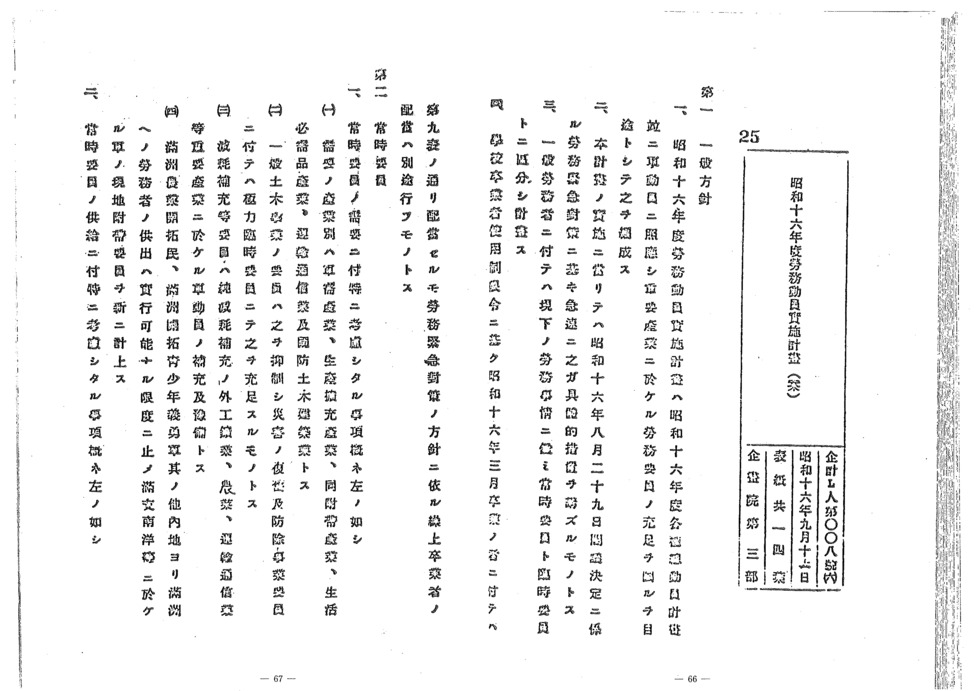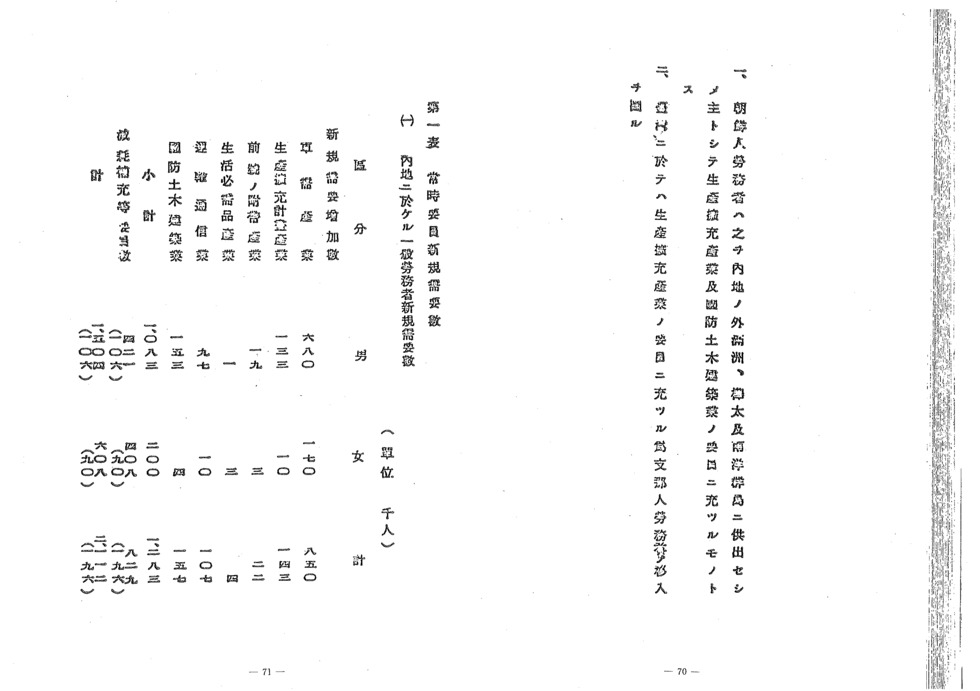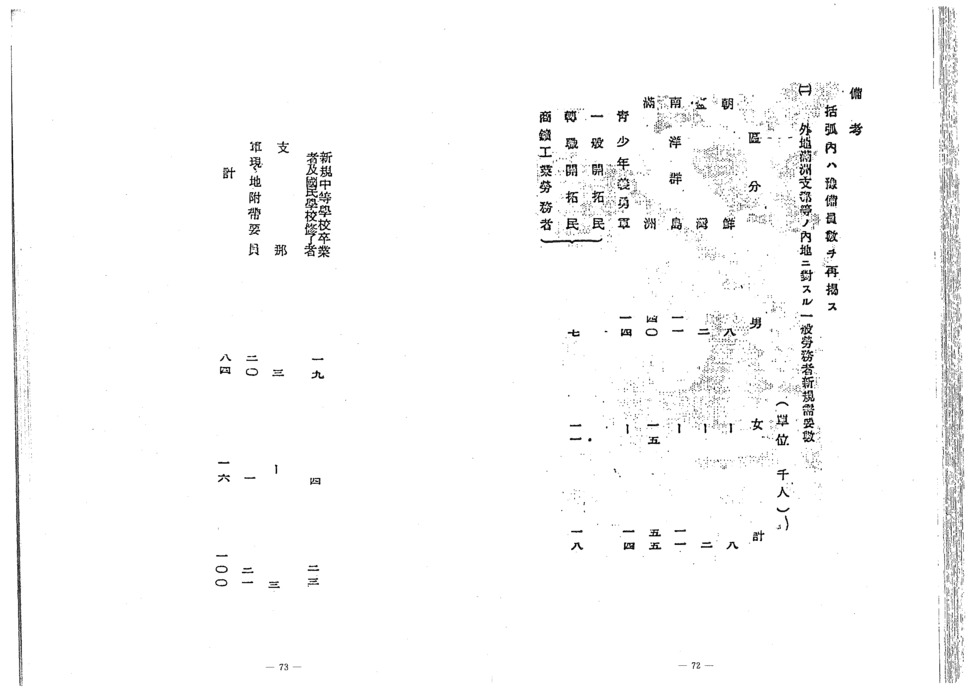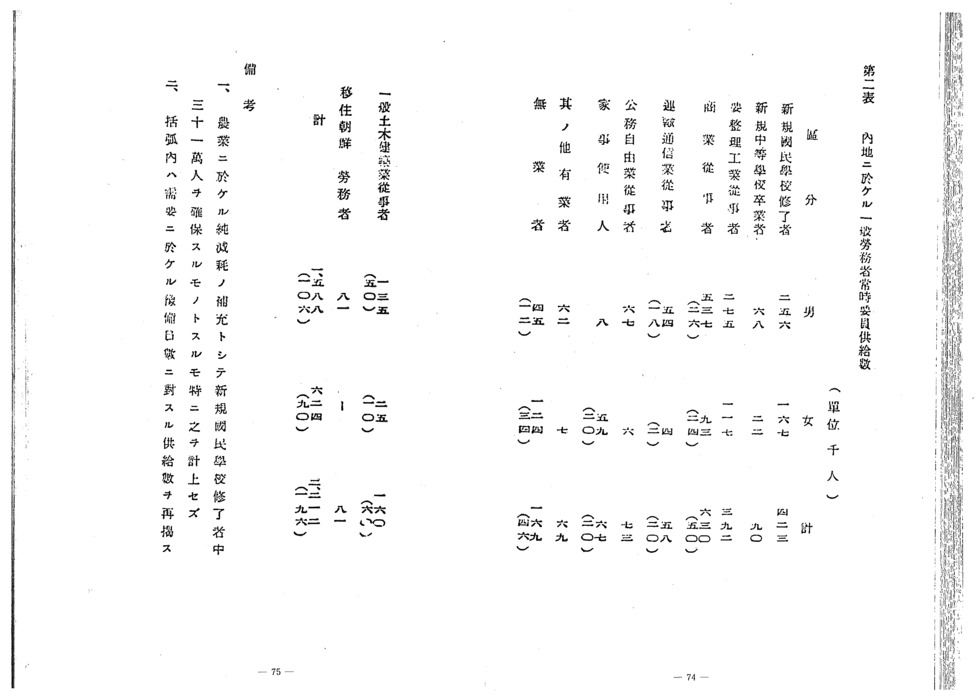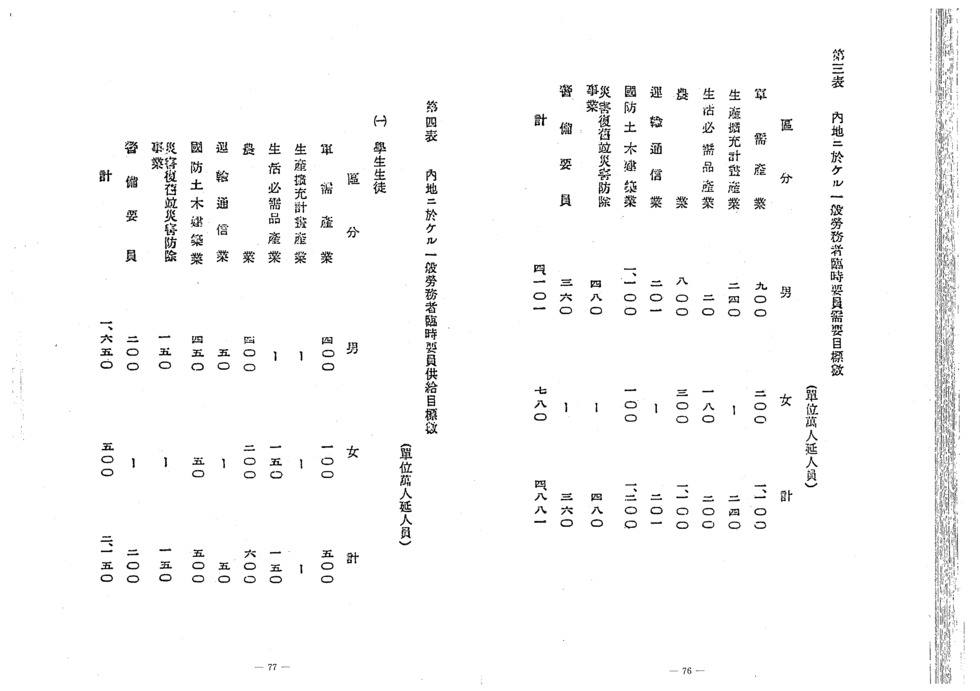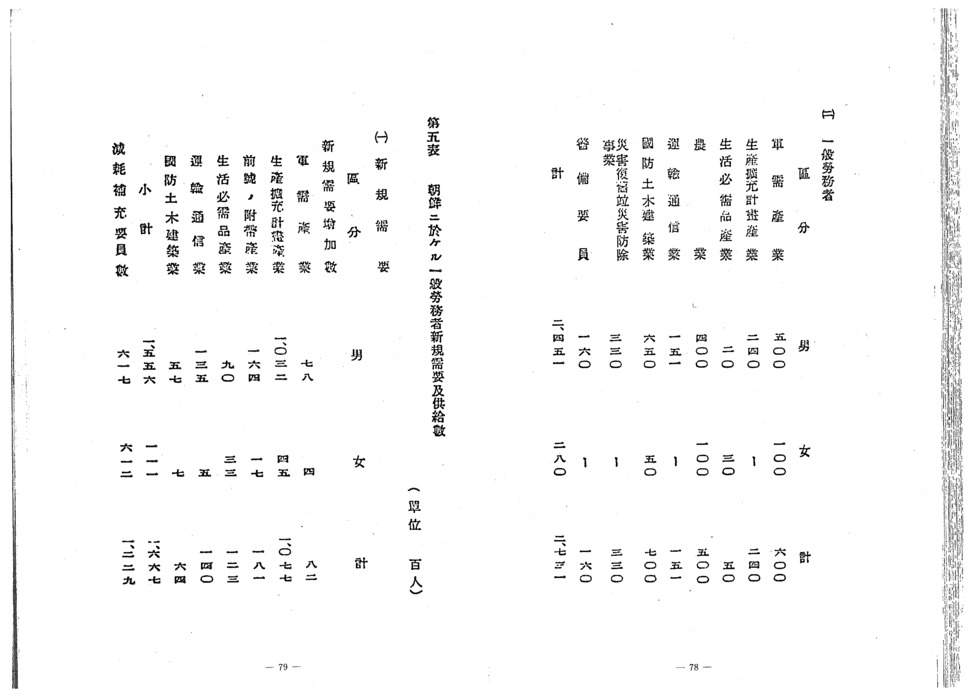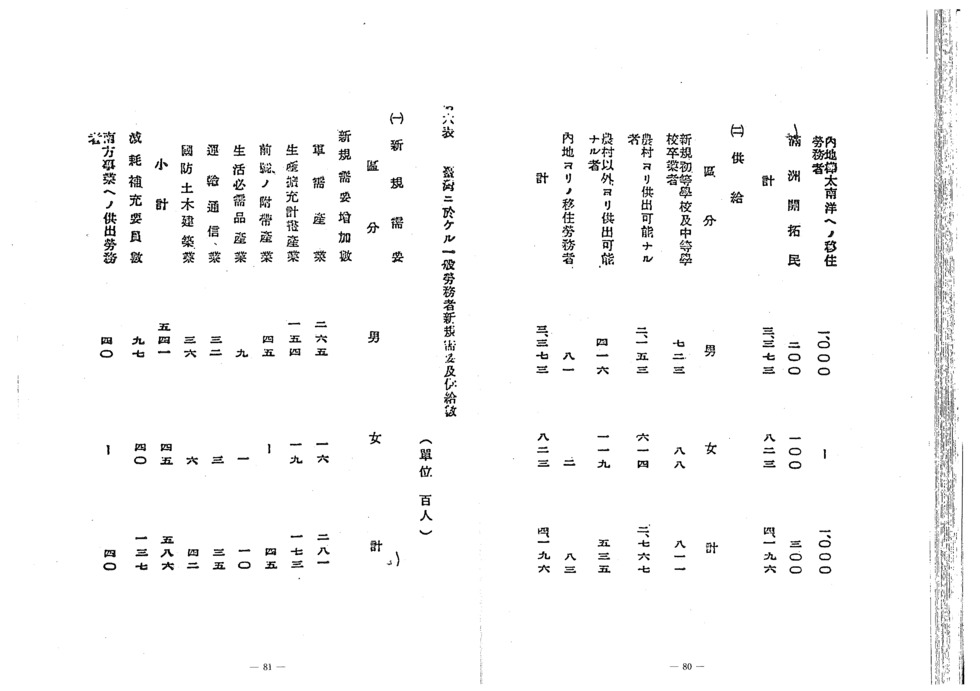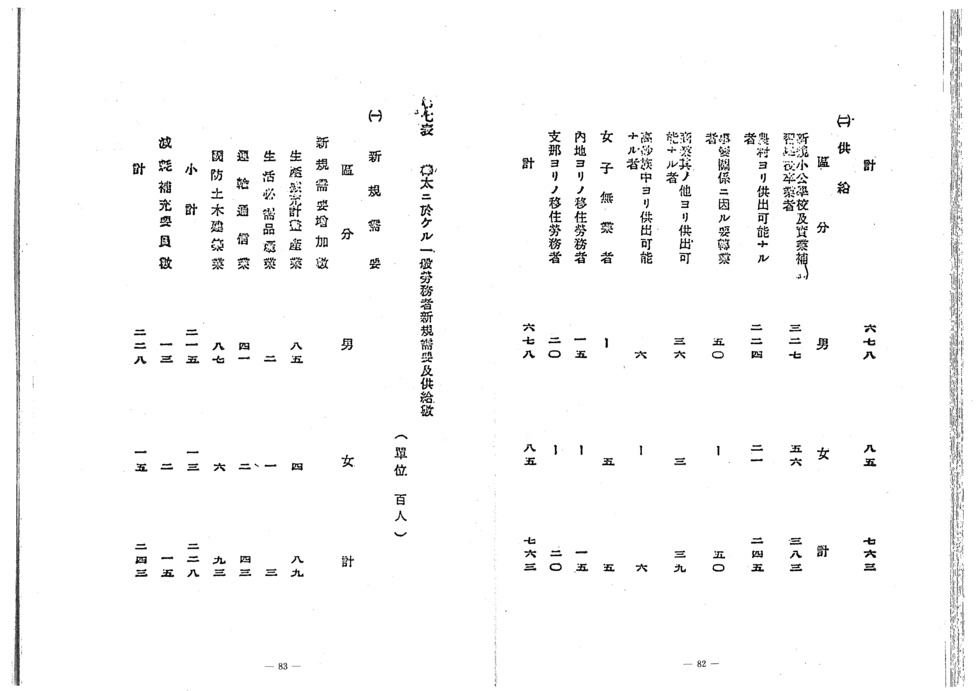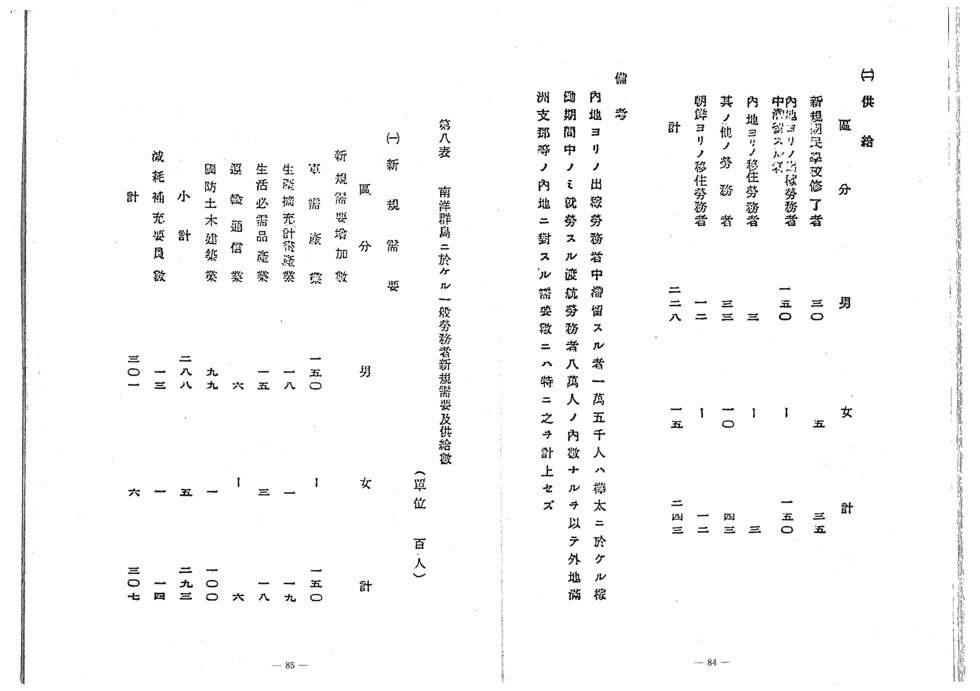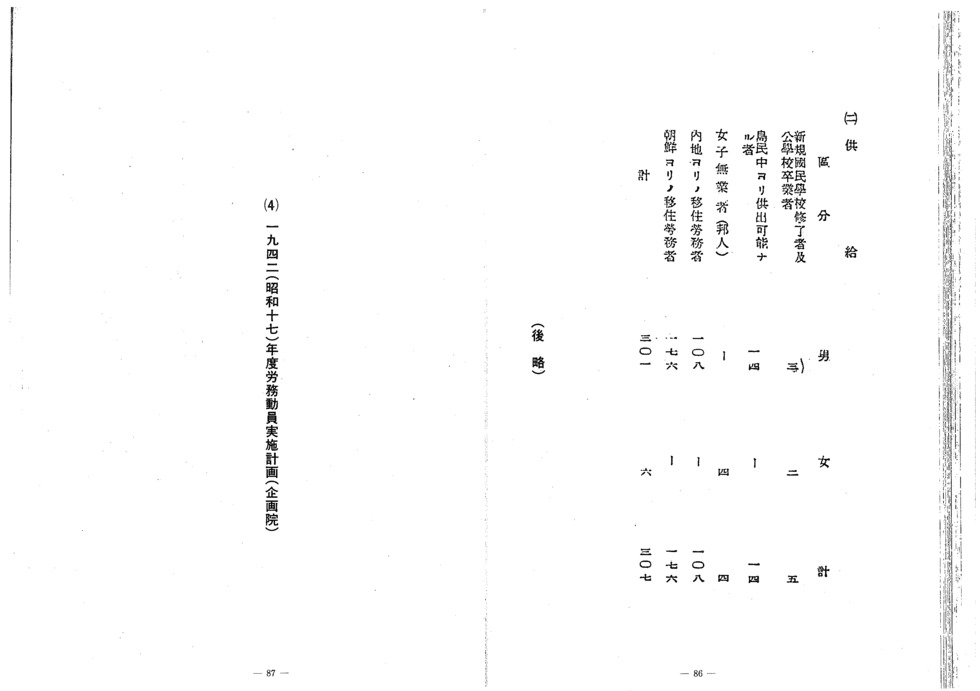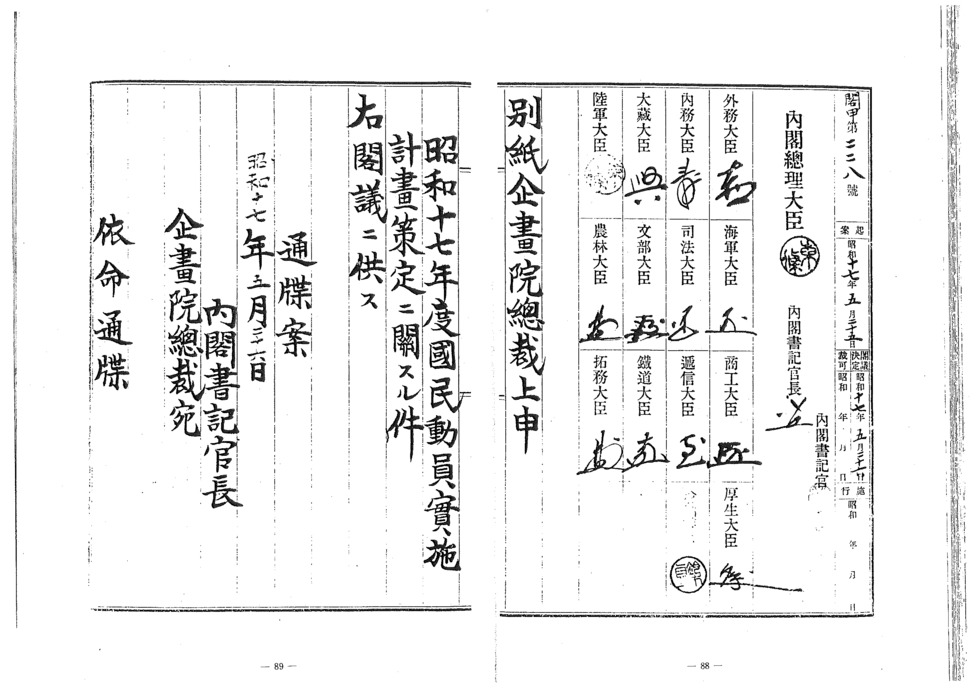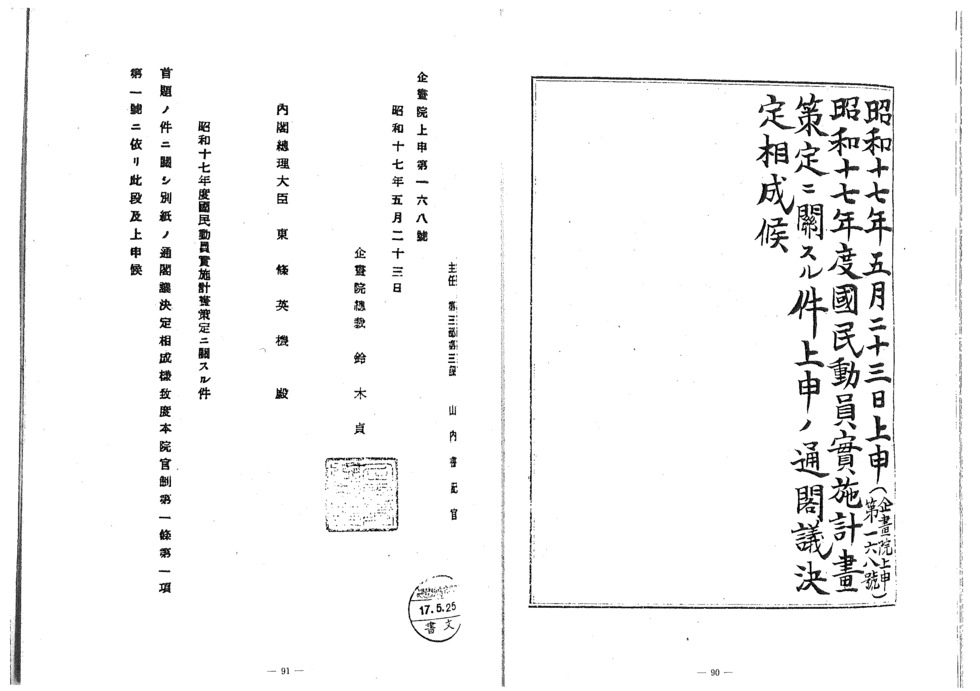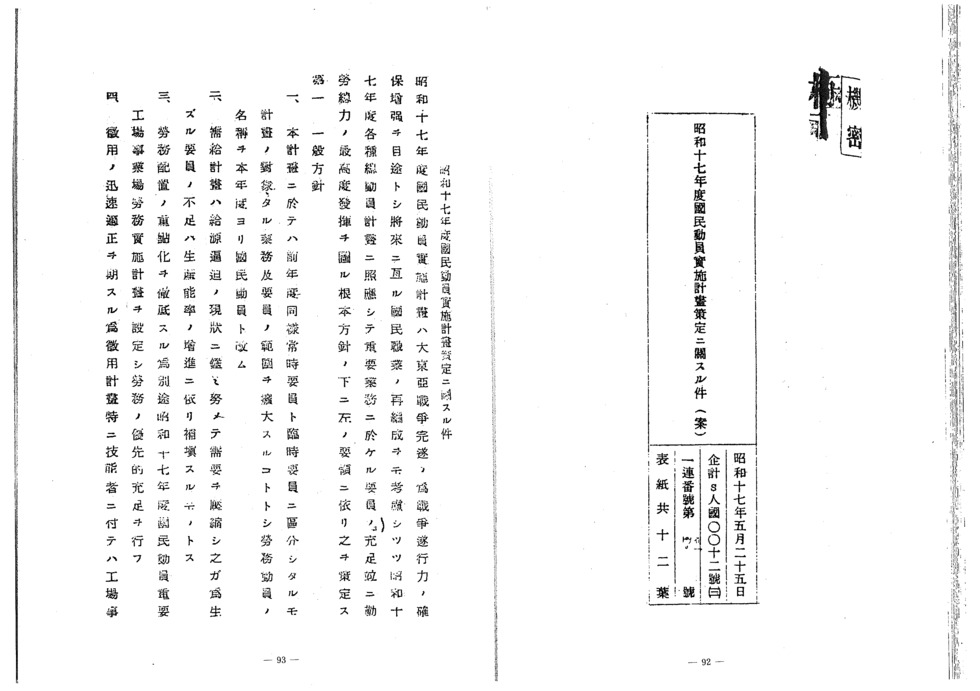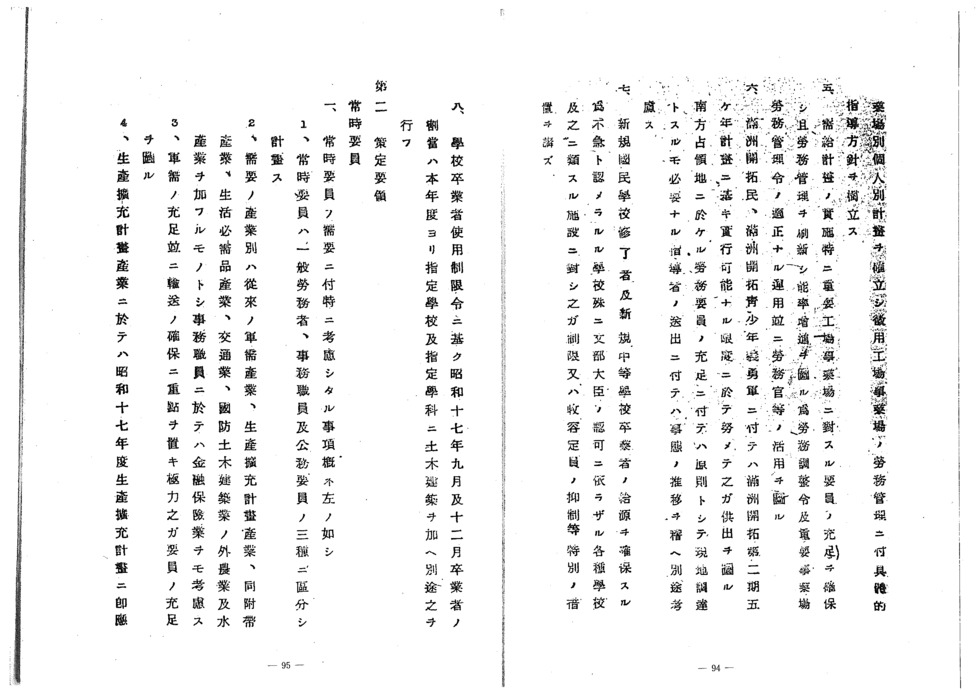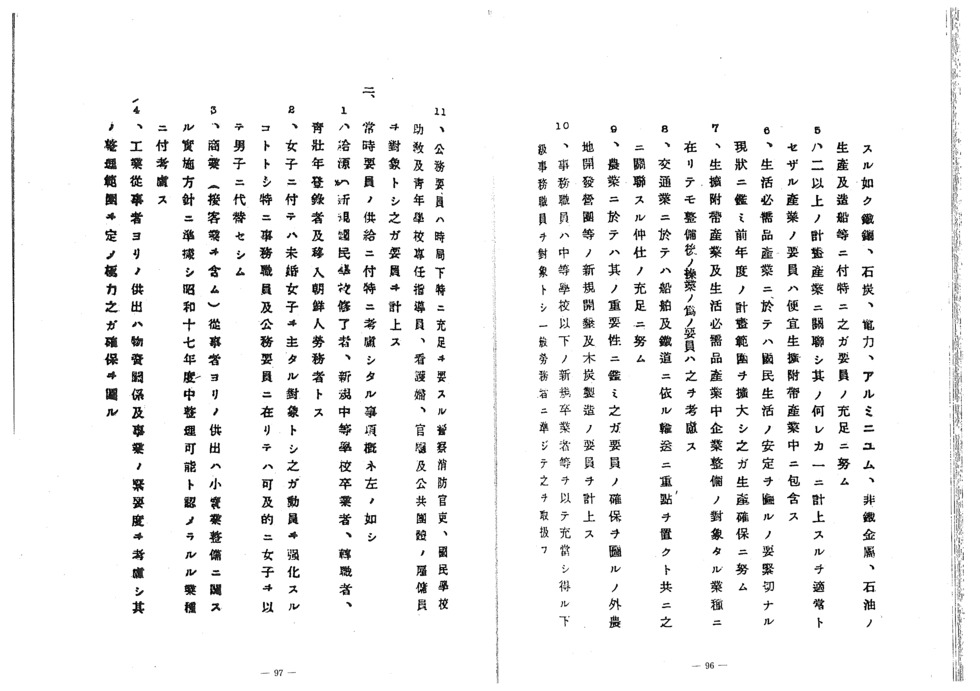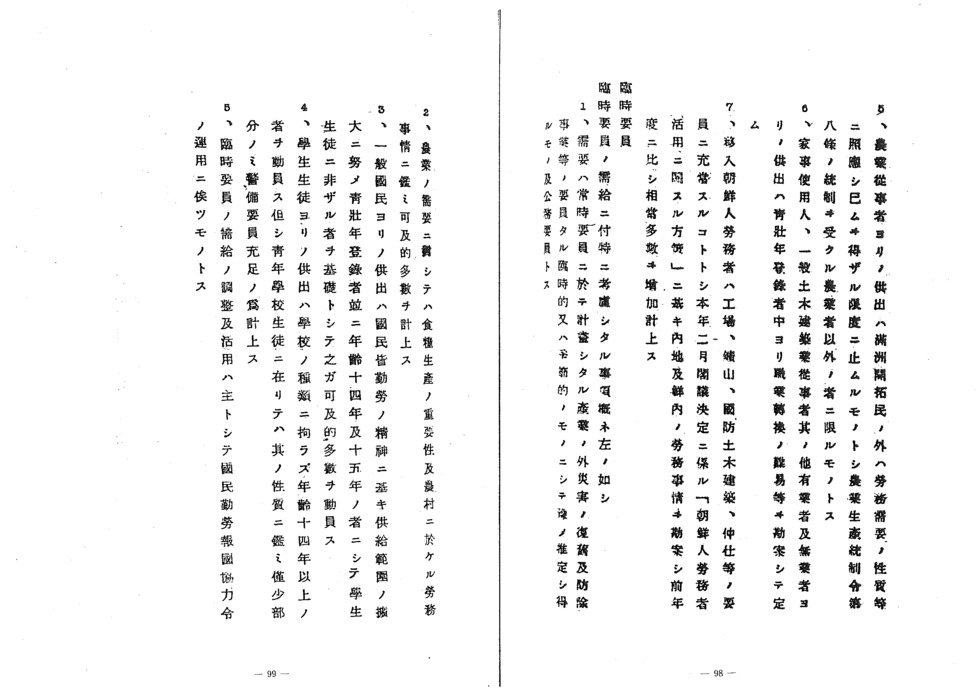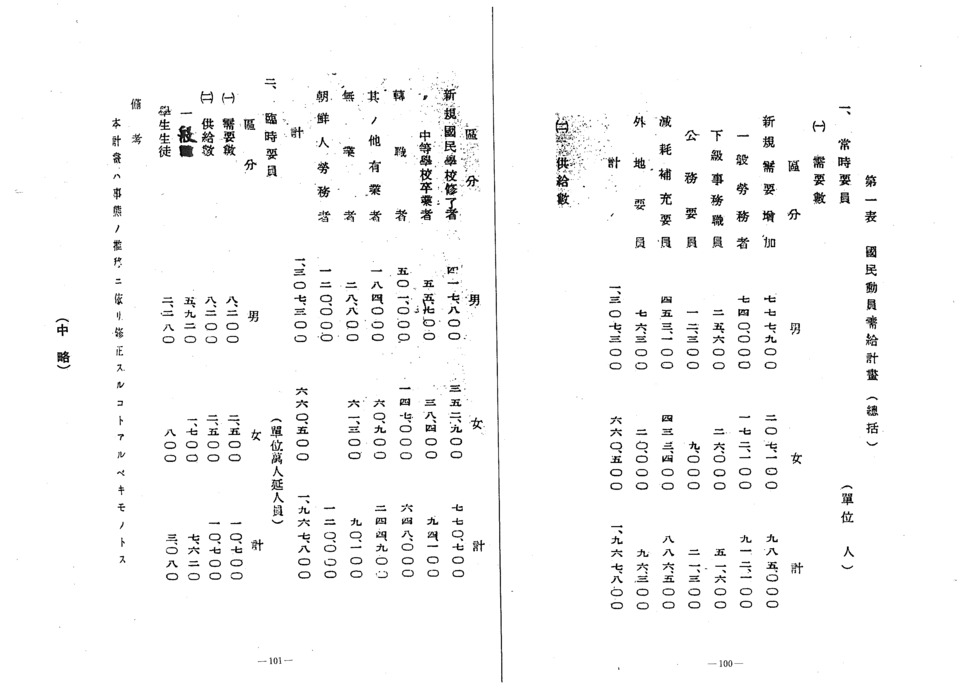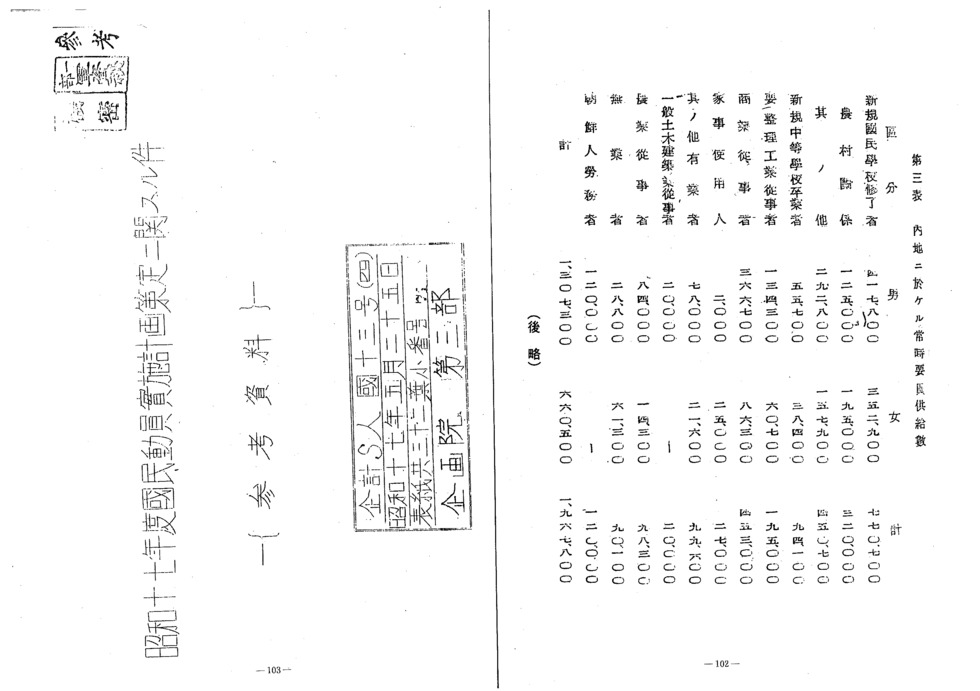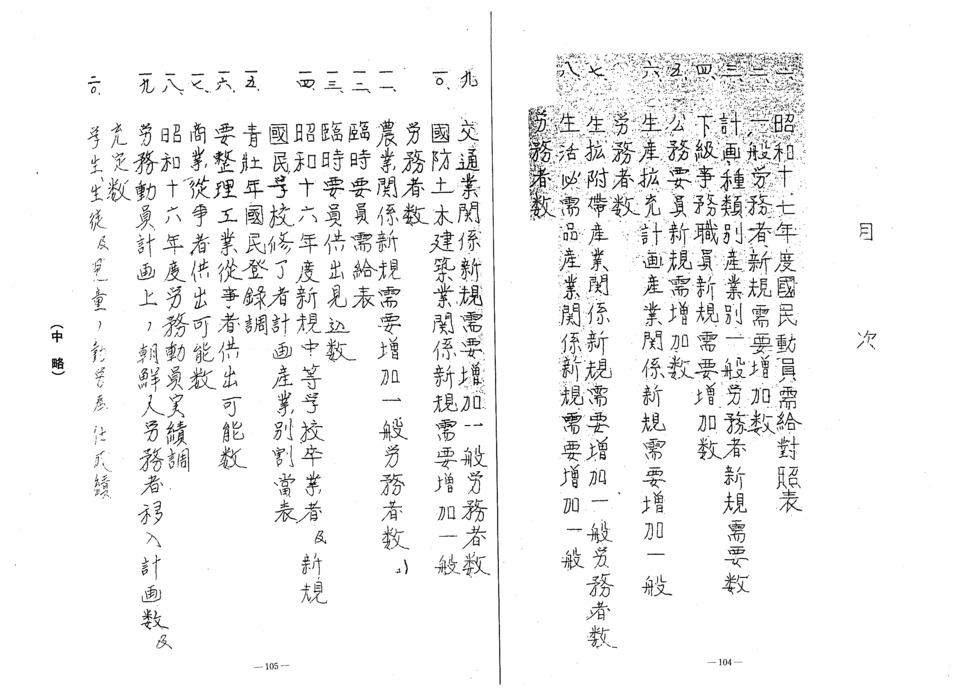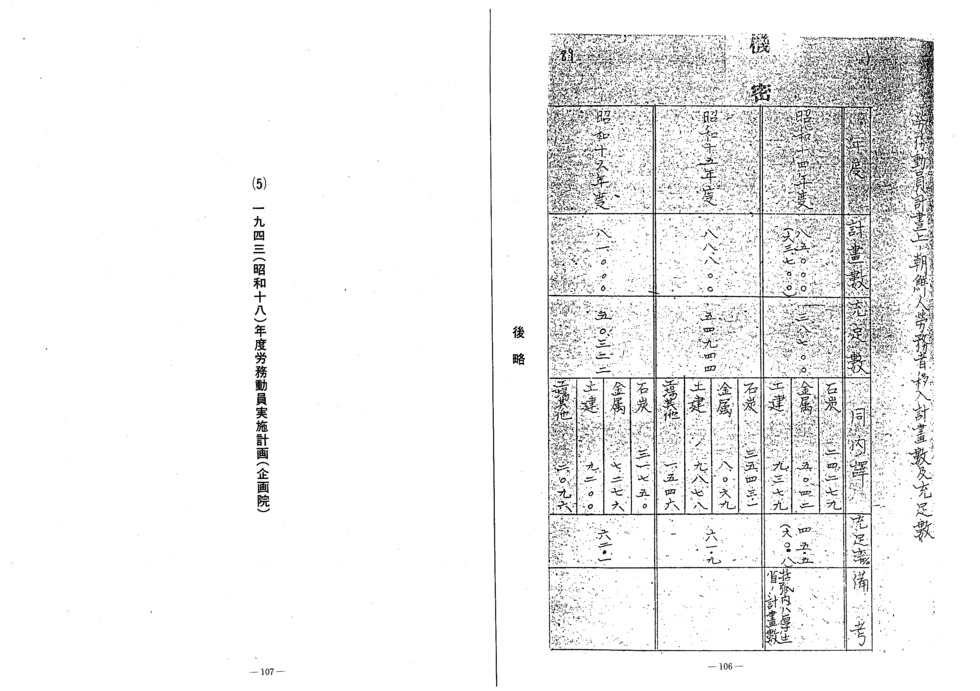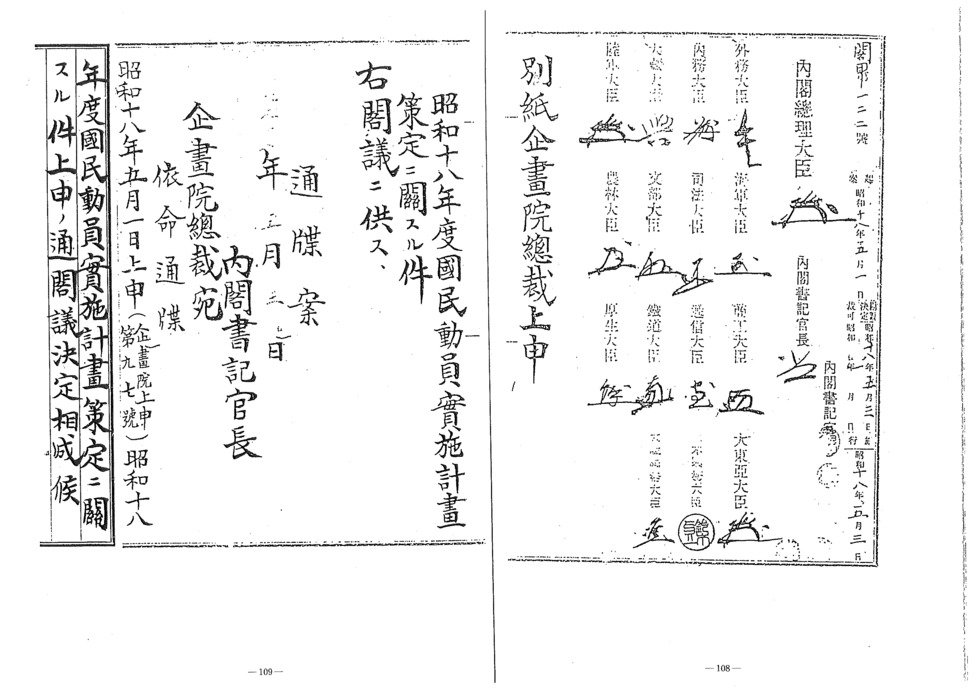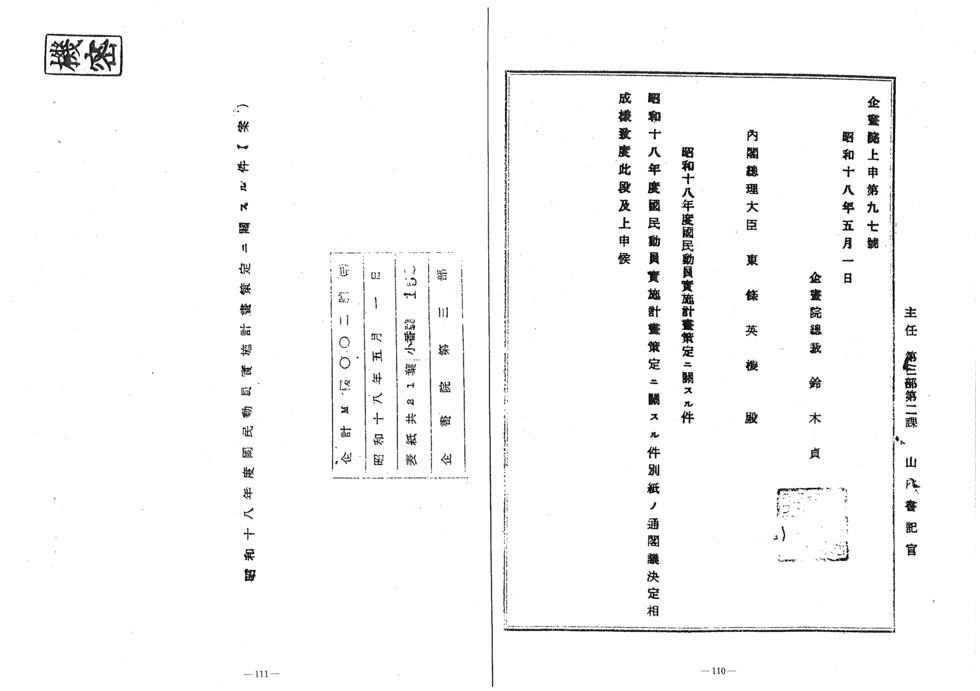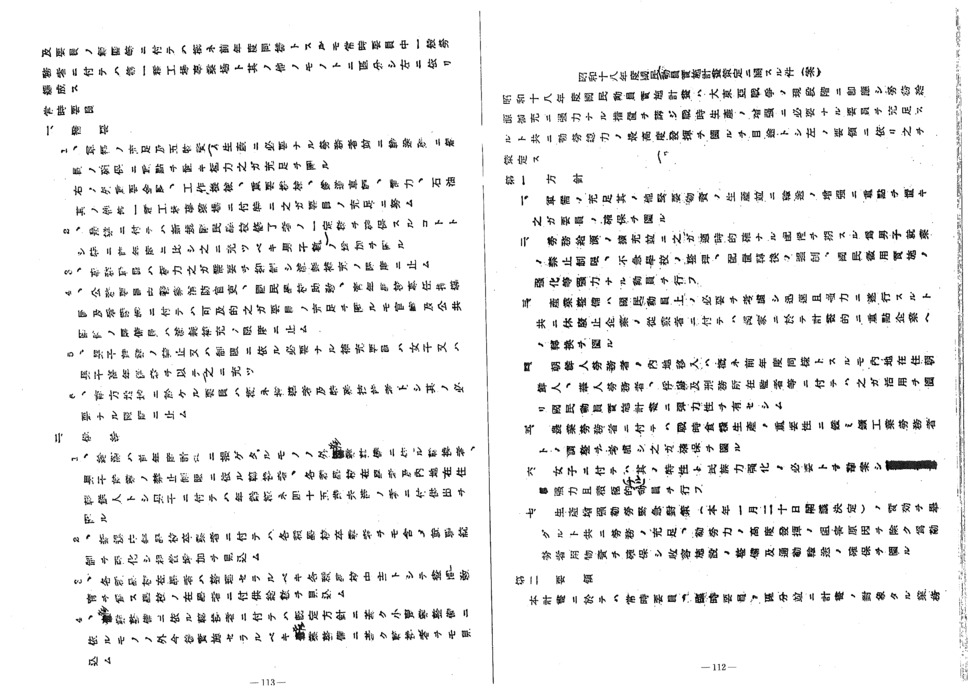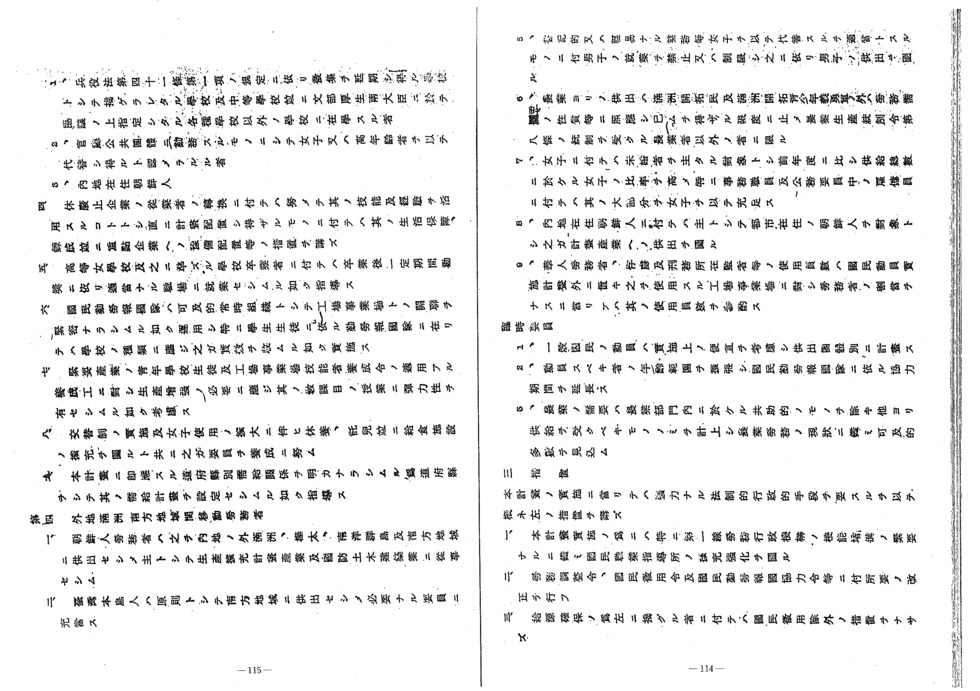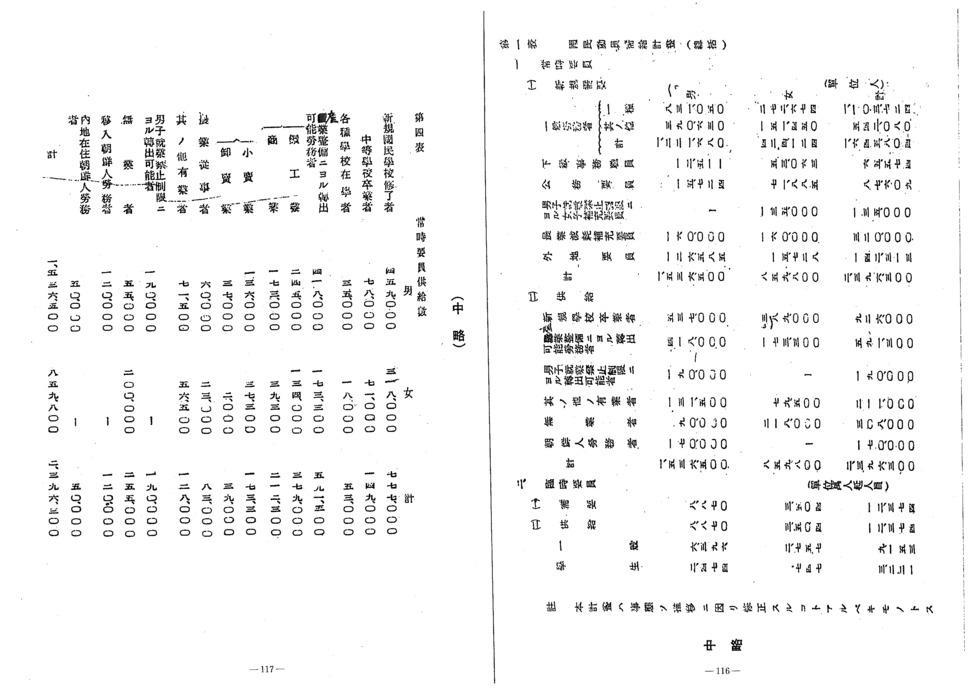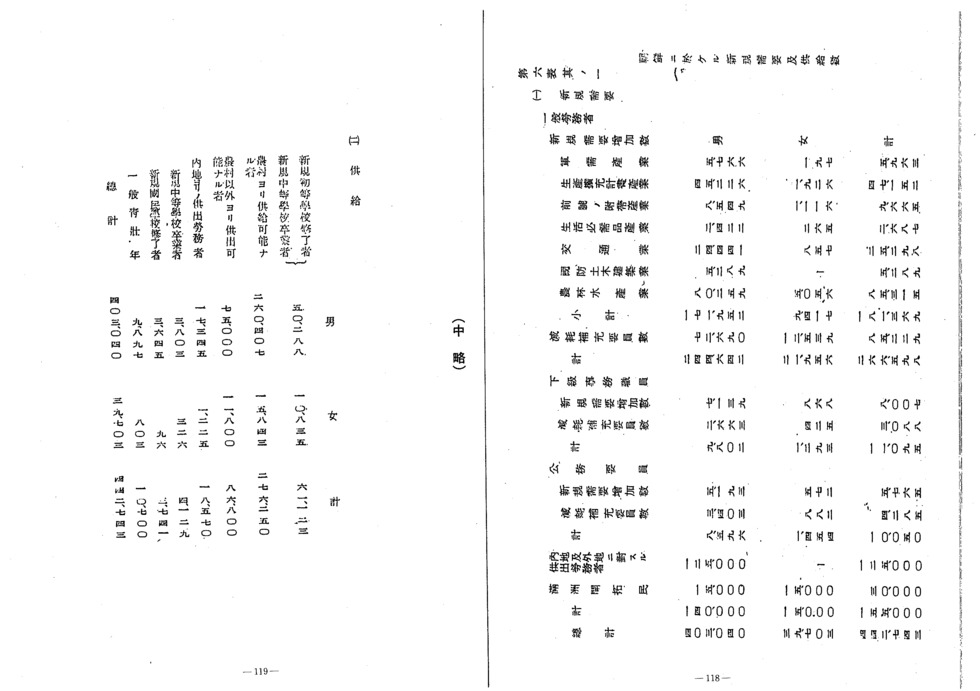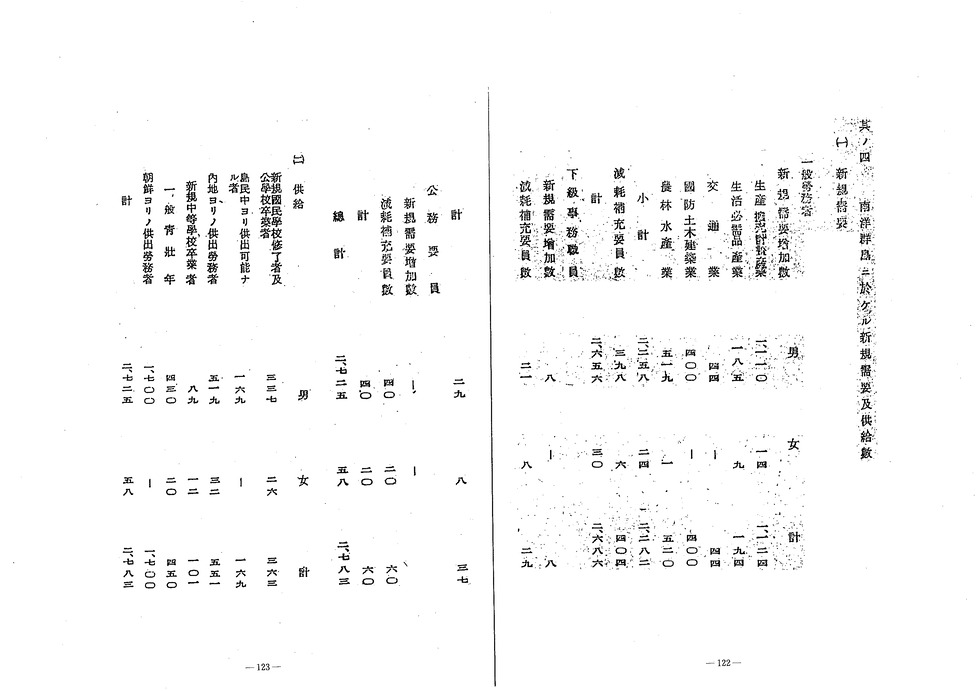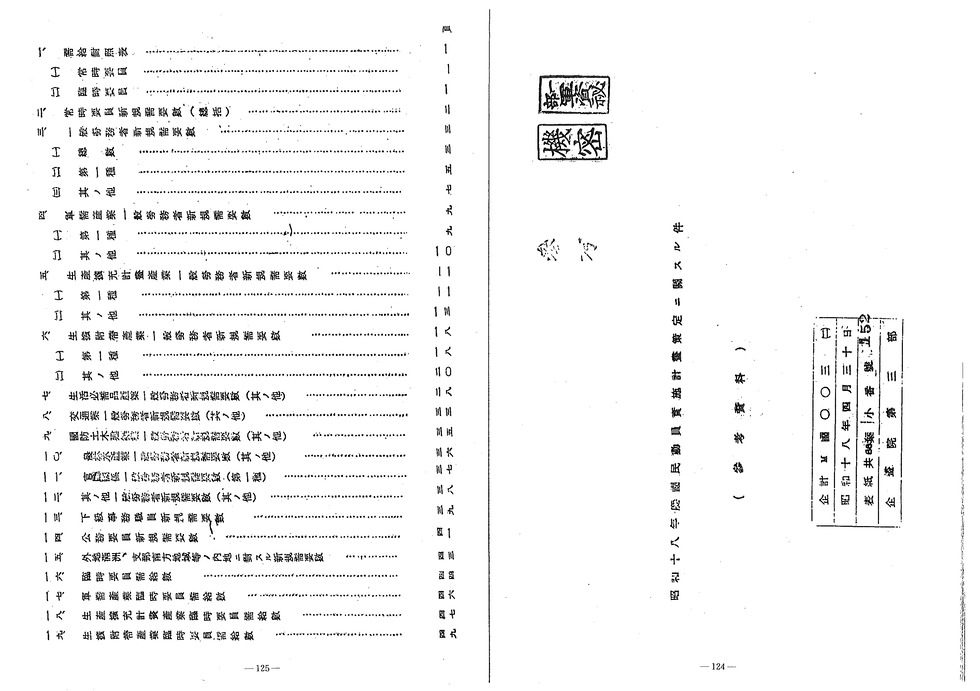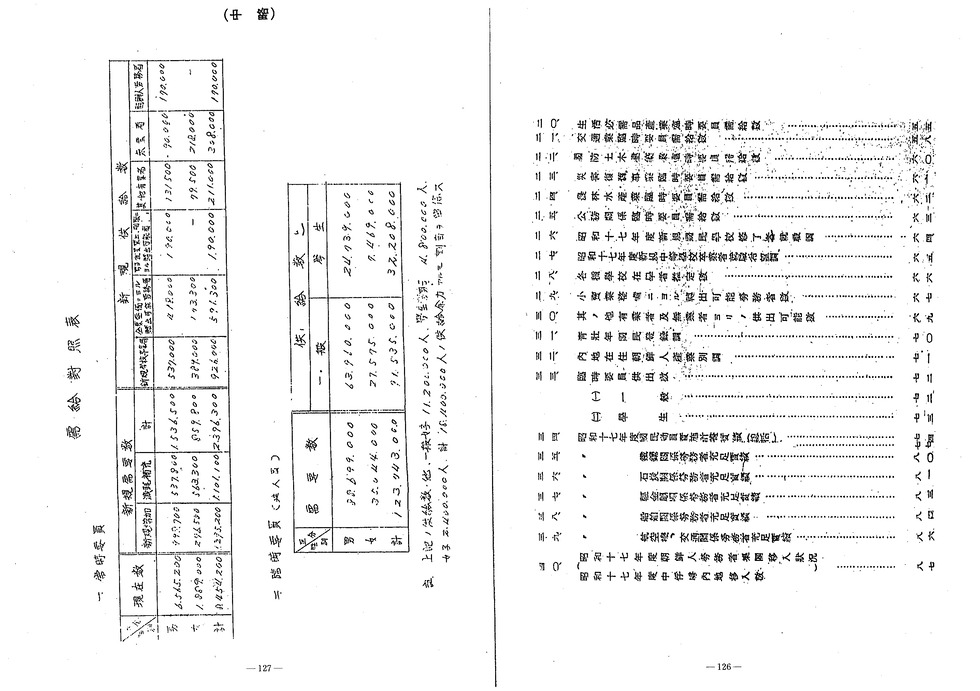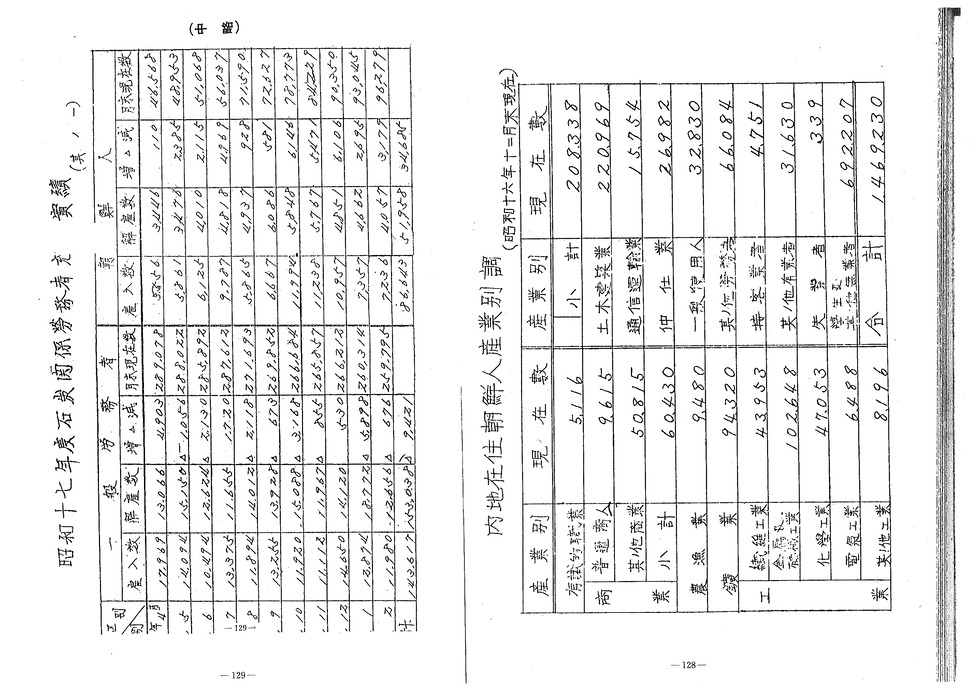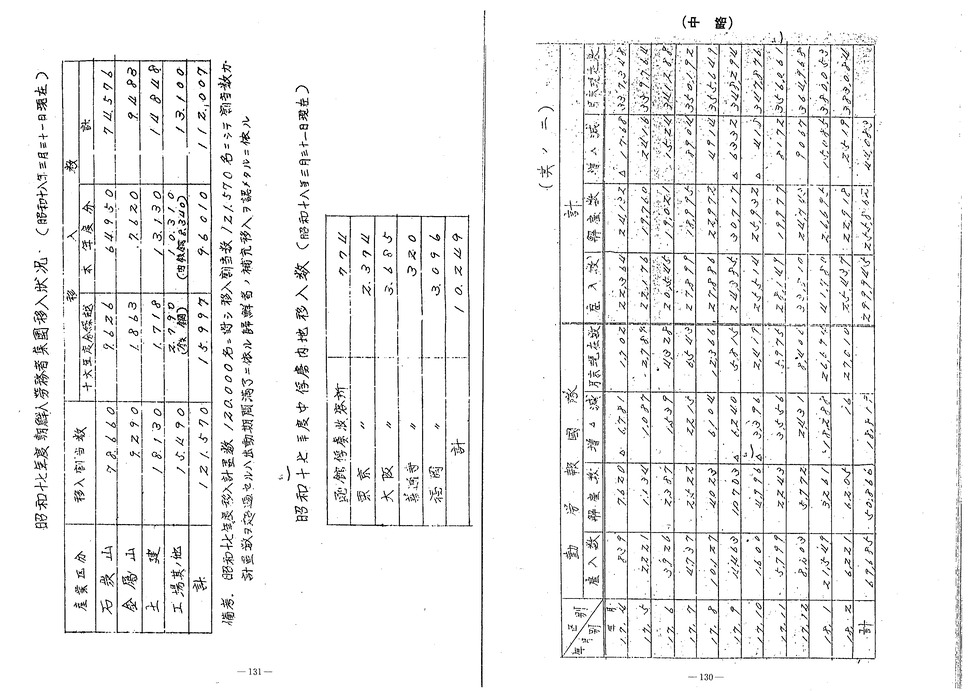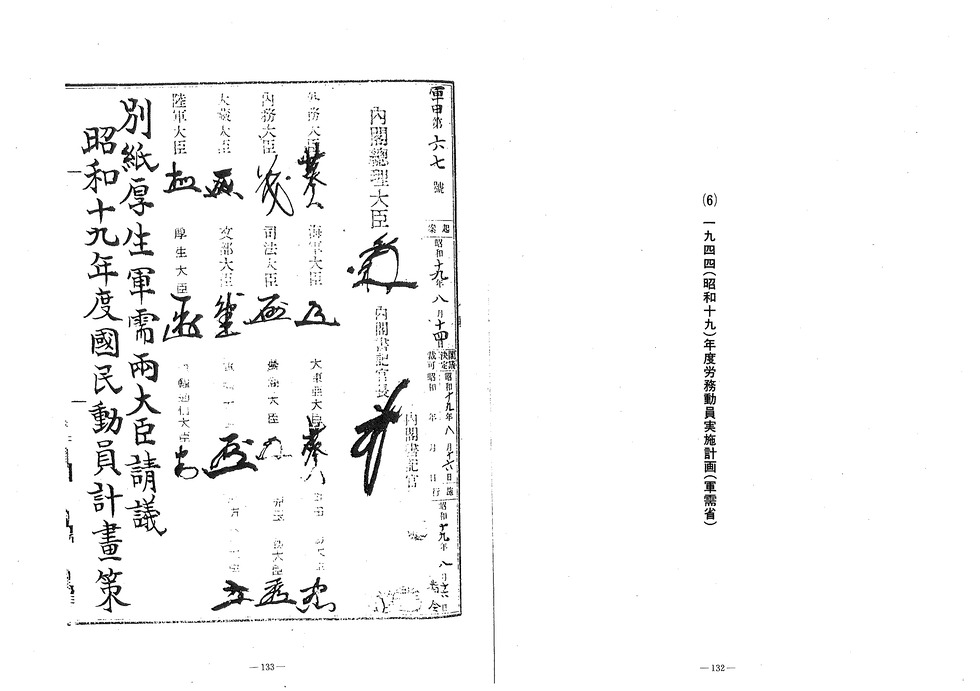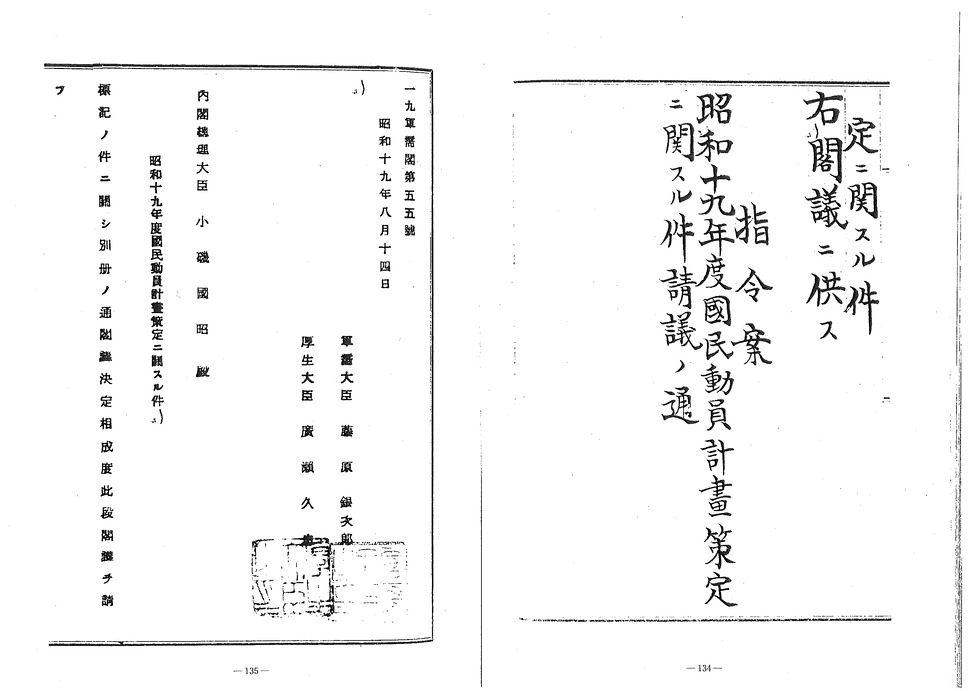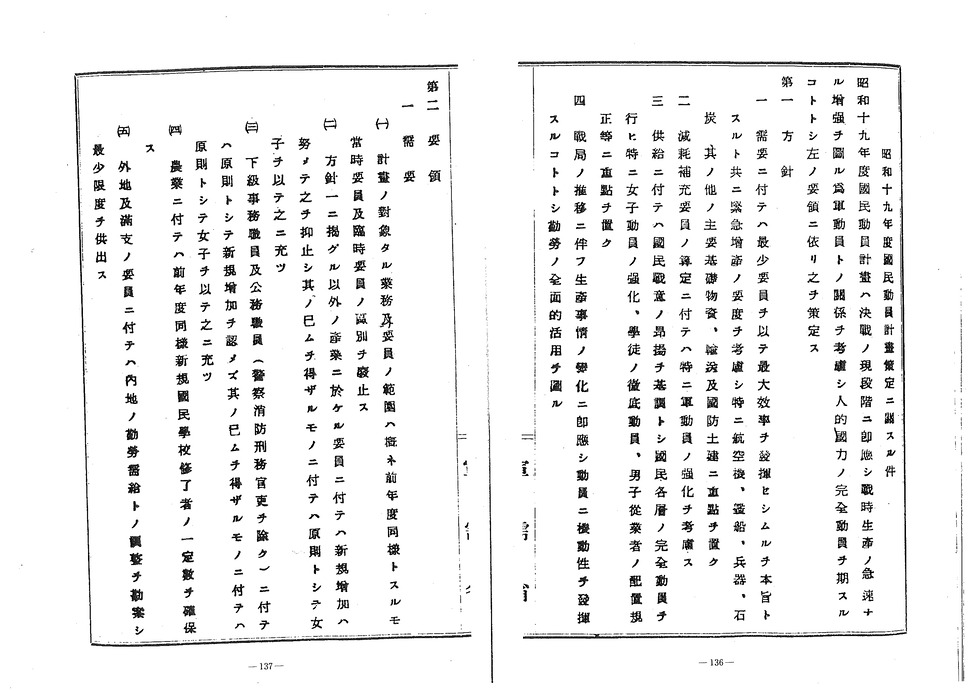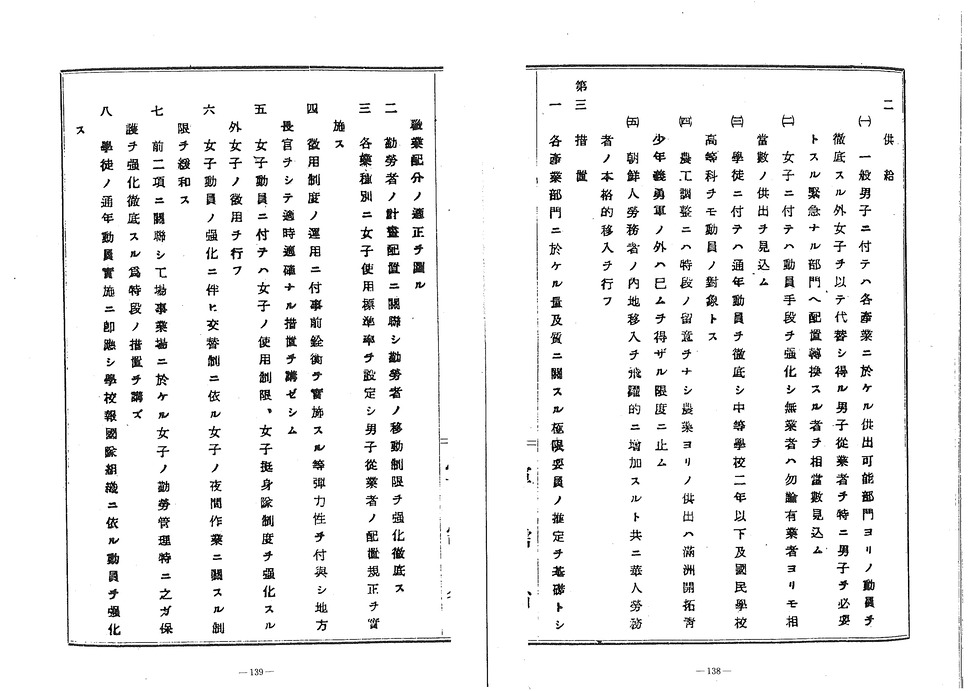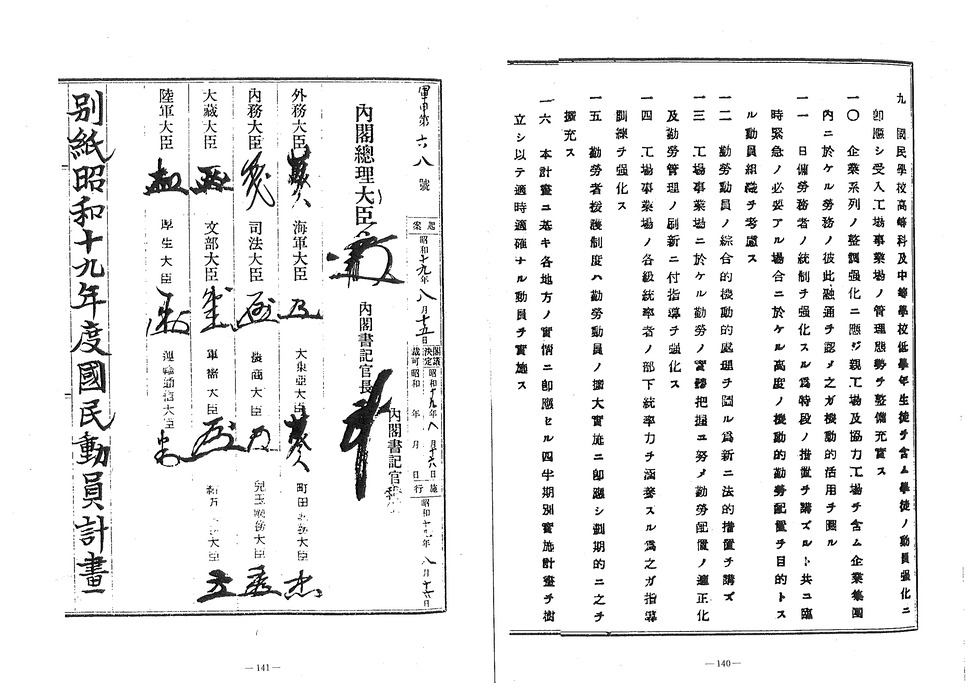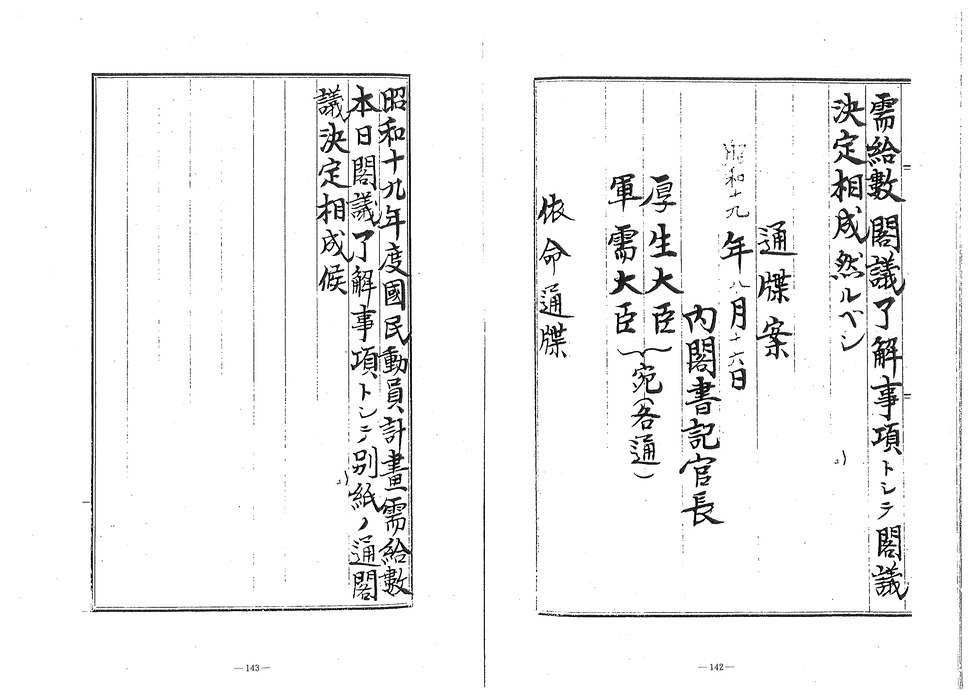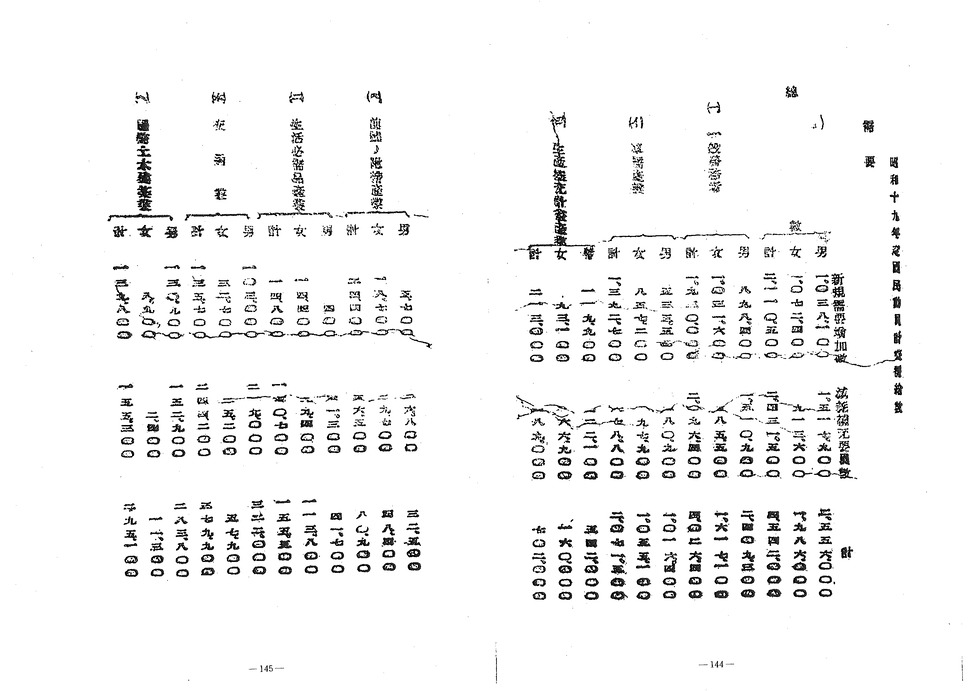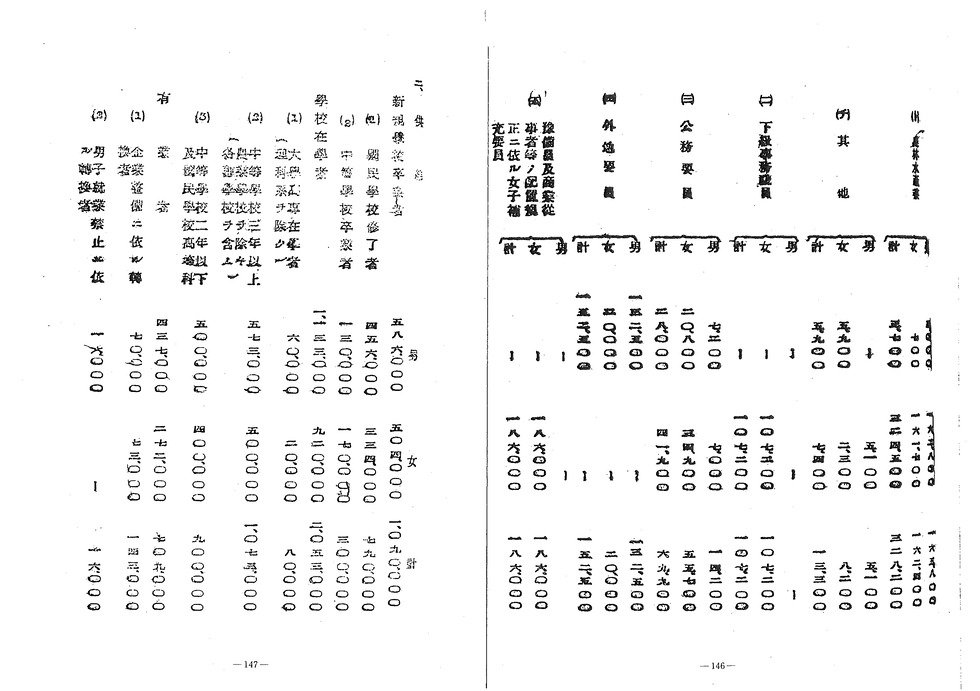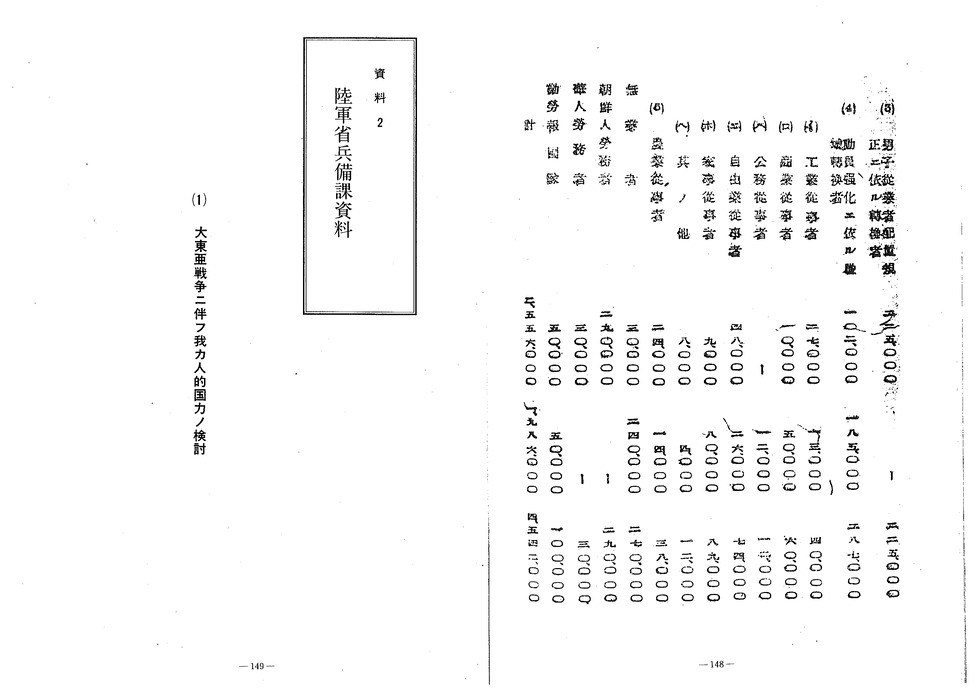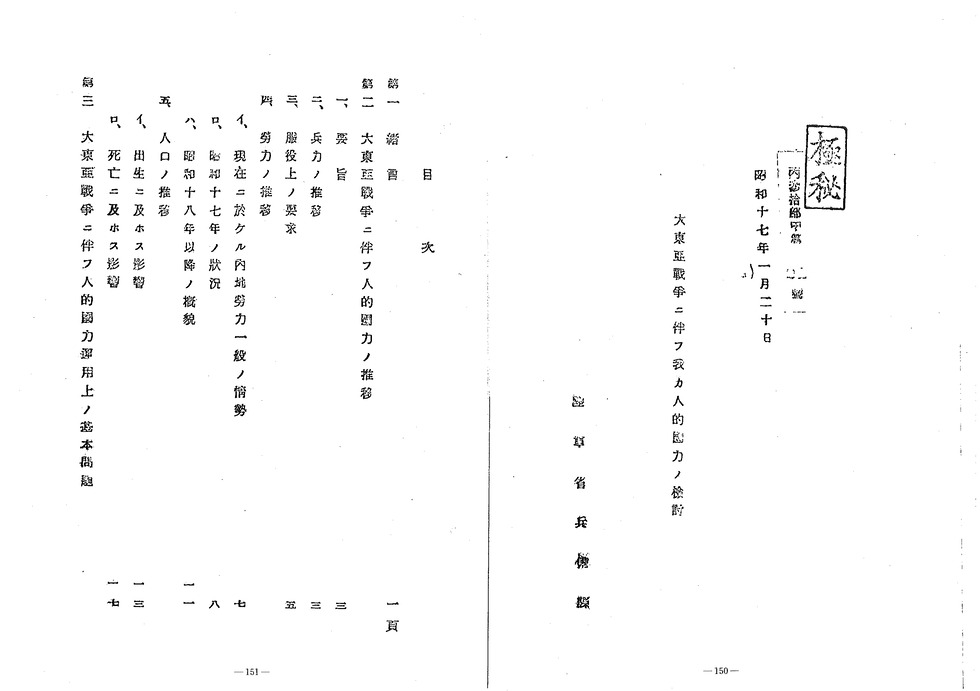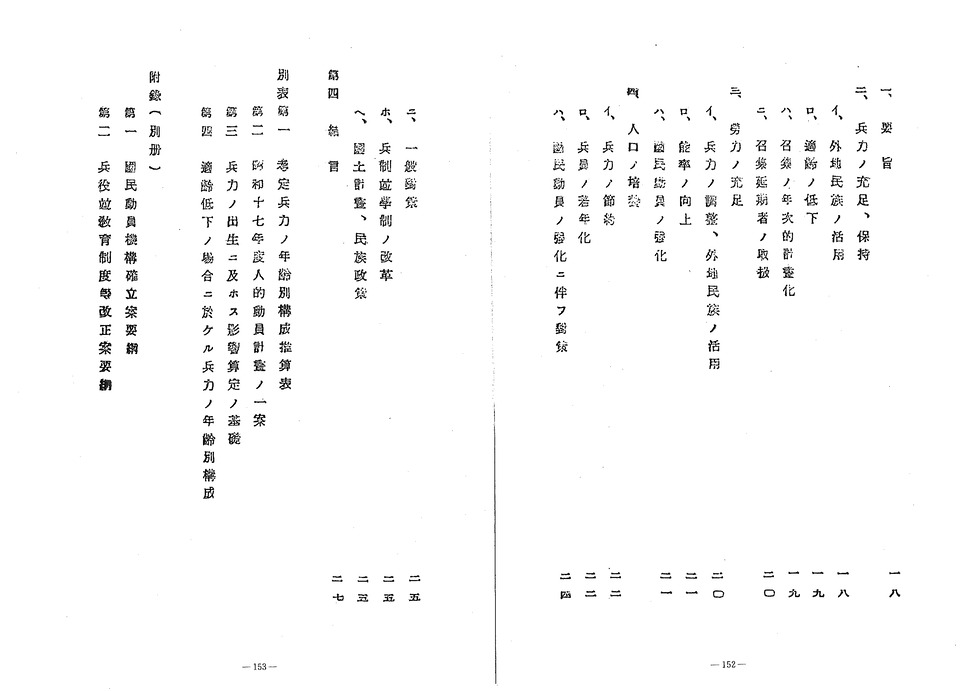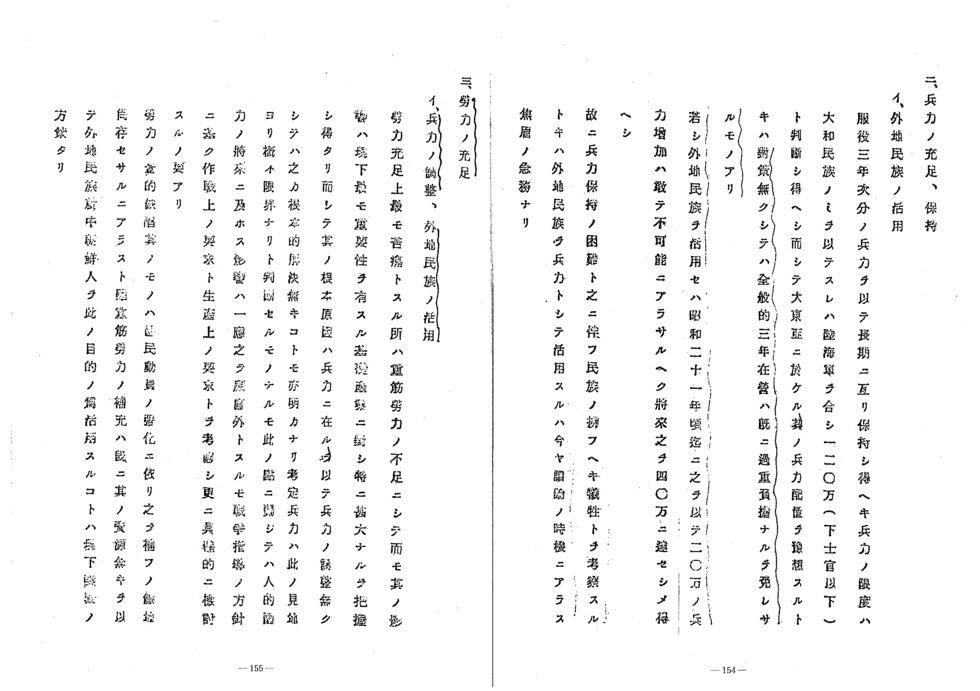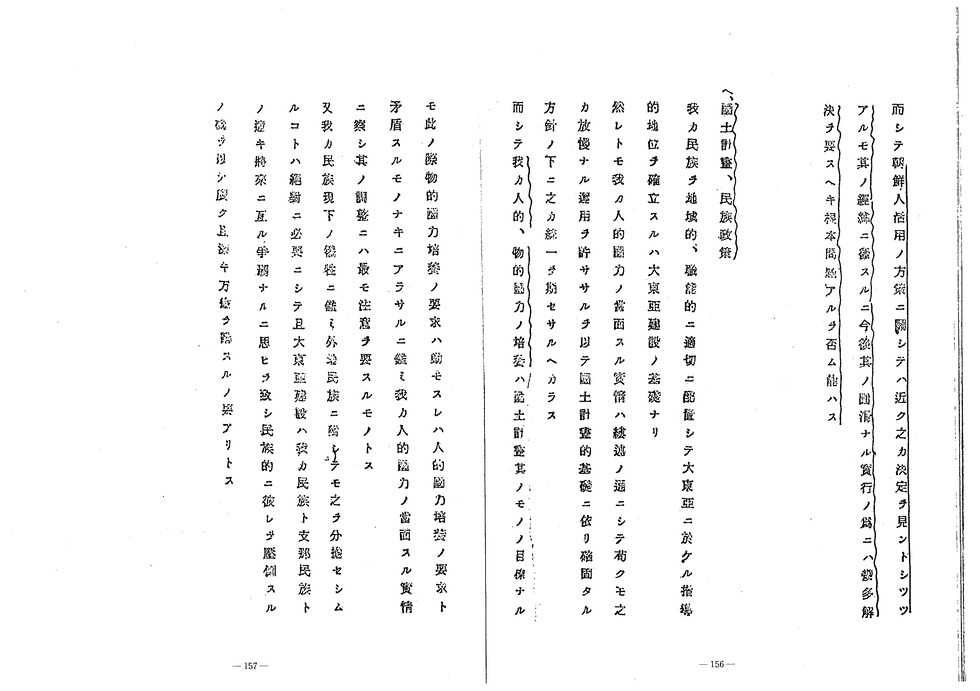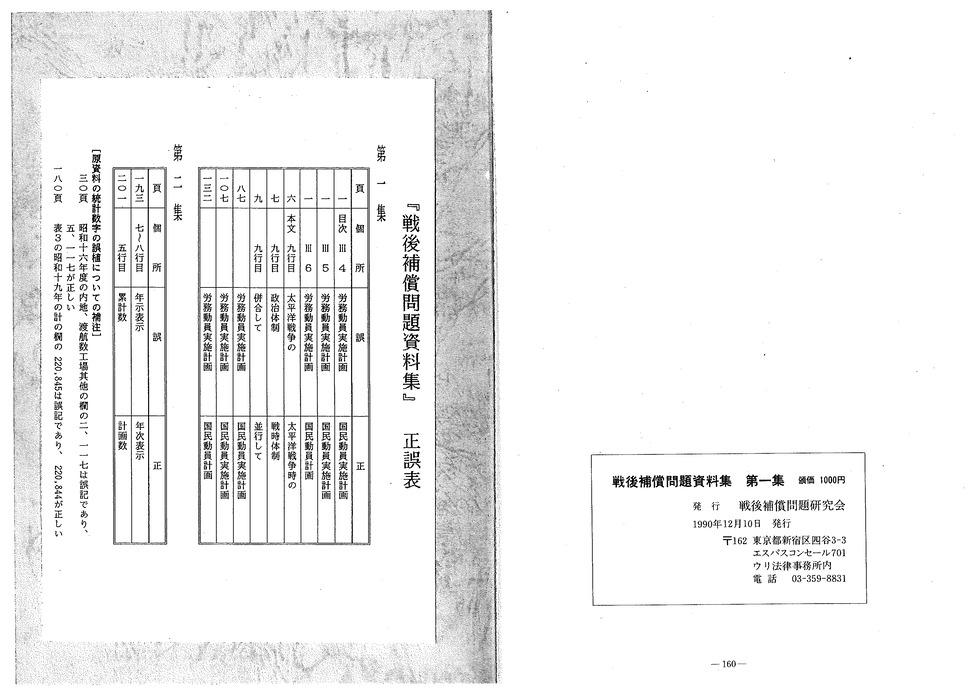Documents Related to the Post-War Compensation Issue Vol. 1
Publication year:1990
- Author
Page 1
Page 2
Page 3
Page 4
Page 5
Page 6
Page 7
Page 8
Page 9
Page 10
Page 11
Page 12
Page 13
Page 14
Page 15
Page 16
Page 17
Page 18
Page 19
Page 20
Page 21
Page 22
Page 23
Page 24
Page 25
Page 26
Page 27
Page 28
Page 29
Page 30
Page 31
Page 32
Page 33
Page 34
Page 35
Page 36
Page 37
Page 38
Page 39
Page 40
Page 41
Page 42
Page 43
Page 44
Page 45
Page 46
Page 47
Page 48
Page 49
Page 50
Page 51
Page 52
Page 53
Page 54
Page 55
Page 56
Page 57
Page 58
Page 59
Page 60
Page 61
Page 62
Page 63
Page 64
Page 65
Page 66
Page 67
Page 68
Page 69
Page 70
Page 71
Page 72
Page 73
Page 74
Page 75
Page 76
P10
1939 Labor Mobilization Implementation Plan (Cabinet Planning Board)
P11-13
Cabinet Notification Type No. 151, July 3, 1939
Adopted by Cabinet Decision on July 4
Annex: Report from Cabinet Planning Board President
Matters related to the Outline of the 1939 Labor Mobilization Implementation Plan
The above was submitted to the Cabinet for deliberation.
Draft Notice
July 4, 1939
Cabinet Secretary-General
To: Cabinet Planning Board President
Notification
A Cabinet Decision has been made on the matters relating to the Outline of 1939 Labor Mobilization Implementation Plan submitted by the Planning Board with its Report No. 60 dated July 3, 1939
P14
Planning Board Report No. 60
July 3, 1939
Planning Board President Kazuo Aoki
To: Prime Minister Baron Kiichiro Hiranuma
Matters relating to the Outline of the 1939 Labor Mobilization Plan
I hereby request that a Cabinet Decision be made on the Outline of 1939 Labor Mobilization Plan as attached.
P15-
Outline of 1939 Labor Mobilization Plan (Draft)
Outline of 1939 Labor Mobilization Plan
Chapter 1 General Rules
- This Outline shall stipulate matters to serve as the basis for implementation of the 1939 Labor Mobilization Plan pursuant to the Cabinet Decision of September 13, 1938 on matters related to the establishment of National Mobilization Plan.
- The purpose of the Outline shall be to develop the basis for a labor force under the circumstances of a protracted war, and in particular to control and make use of labor in such a manner as to achieve the objectives noted below.
(1) To meet war materiel needs
(2) To execute the Production Capacity Expansion Plan
(3) To stimulate exports
(4) To secure the necessities for daily life
- Agencies shall promptly draw up and put into effect their own plans based on the Outline.
The institutions related to Manchuria and China shall establish plans for carrying out labor mobilization according to the purposes of the Outline and design and put into effect appropriate measures.
The above-noted plans to be established by various agencies as well as the plans for labor mobilization by Manchuria- and China-related institutions noted above shall be submitted immediately to the Cabinet Planning Board.
- Where a particularly important matter arises in relation to the carrying out of labor mobilization, the Labor Mobilization Committee shall coordinate its handling.
Chapter 2 Supply and Demand Coordination Measures for General Workers
- The 1939 Supply and Demand Plan for General Workers shall estimate and establish supply capacity based on new demand for laborers in the fields of manufacturing, mining, and transportation in Japan.
The above plan shall take into consideration supply and demand with respect to Manchurian settlers, etc.
- The above-noted number of workers required shall be calculated as the total number of personnel for the various categories below.
(1) The number of additional workers needed in the munitions industry, those industries targeted by the Production Capacity Expansion Plan and associated industries, the export and daily necessities industries, and the transportation and communications industries
(2) The number of workers to replenish personnel in the manufacturing, mining, and transportation and communications industries
(3) Manchurian settlers, etc.
The above personnel numbers shall be as in the attached Tables 1 and 2.
- The above demand for workers shall be met from the sources noted below.
(1) Those who have graduated from elementary school in March 1939
(2) Those who have lost their jobs through execution of the Resource Mobilization Plan
(3) Those who have not yet found work (including assistants)
(4) Those engaged in farming
(5) Those engaged in work that could be cut back, such as commerce
(6) Women without jobs
(7) Korean migrants
The targets for the number of workers to be supplied from the above sources shall be as noted in the attached Table 3.
- To meet the above demand, even more proactive measures shall be designed in relation to job guidance and placements, and control shall be strengthened particularly in relation to the employment of those who have just graduated from elementary school and other young people.
- Occupational guidance facilities shall be expanded and other measures devised so that workers who have lost their jobs through execution of the Resource Mobilization Plan and youth and middle-aged adults who intend to change their jobs can contribute necessary labor.
- Given the rapid decline in the number of young agricultural workers due to labor being supplied from rural areas, as well as the resulting regional bias, the supply of laborers shall be systematized and measures taken to ensure closer liaison between rural labor administration institutions and the Economic Regeneration Committee, etc.
To secure agricultural production, an Agricultural Labor Coordination Plan shall be established and measures including the collectivization of work and facilities, the use of groups of mobile laborers, the use of volunteer labor, and the expansion of the use of facilities for joint childcare, joint cooking, and other housework, as well as the use of livestock and machinery will be employed in a unified manner to ensure efficient labor utilization, and the supply of seasonal laborers shall be coordinated among rural areas and cities.
- In industries such as commerce where it is comparatively easy to cut back on labor, methods such as improved management shall be used to save labor; other appropriate measures will also be devised, such as restrictions on the employment of male and female young workers pursuant to Article 6 of the National Mobilization Law in cases not requiring the urgent use of the young workers.
- In relation to women workers, appropriate guidance shall be provided to women in choosing workplaces with the priority placed on meeting demand in those industries which require women workers, such as the export industry; unemployed women who are not married shall be actively encouraged to take up employment.
- Korean workers shall be brought in from Korea and, based on appropriate measures, shall be put to work in those areas where their labor is particularly necessary.
- Where a shortage of general workers could pose a major obstacle to the execution of the Labor Mobilization Implementation Plan, if there are no other appropriate measures to make up for this shortage, conscription of workers shall be employed.
- In the case of places outside Japan, measures for the coordination of supply and demand for general workers shall be established in accordance with the aims of this chapter.
* Chapters 3 to 5 have been omitted.
* Annexes 1 to 5 are omitted.
P27
The 1939 Labor Mobilization Plan and Capital Control Plan
(Announced on July 4, 1939 by the Cabinet Planning Board President)
Following the government’s recent adoption of the 1939 Resource Mobilization Plan, Foreign Trade Plan, and the Transportation and Power Mobilization Plan, the Cabinet Planning Board drew up the 1939 Labor Mobilization Plan and Capital Control Plan in close cooperation with the relevant ministries. These two plans were submitted to and debated and approved by the Cabinet today.
The Labor Mobilization Plan lays out the broad framework for labor mobilization this year, and aims to carry out the most important tasks amidst a long-term war, as with the other mobilization plans: to meet military demand; to execute the Production Capacity Expansion Plan; to boost exports; and to secure daily necessities.
Starting with the supply and demand plan for general workers, the total extra number of male and female workers required is estimated to be around 1.1 million. This number accounts for increased demand in the war materiel industry, in those industries targeted by the Production Capacity Expansion Plan and associated industries, in the export and daily-necessities industries, and in the transportation and communications industries, and also takes into account the need for laborers to replenish the workforces in the manufacturing and transportation industries in Japan, as well as migration to Manchuria from Japan, etc.
To meet the above demand, students who have graduated from elementary school in March this year, persons who have not yet been employed, and persons who have lost their jobs due to execution of the Resource Mobilization Plan will be used to the utmost, with the remaining demand to be met using those engaged in farming, those engaged in commerce or other work that could be cut back, and Korean migrants. There are also areas where it would be appropriate to cut back on young male workers, so unmarried women without jobs will be encouraged to take up employment in those areas as a partial replacement.
Particular thought will be given to the above measures to overcome labor shortages, with appropriate measures taken. Especially when it comes to drawing labor from rural areas, consideration has been given to the necessary measures to secure agricultural production.
The supply and demand plan for engineers and skilled workers has been set based primarily on new demand in the manufacturing, mining, and transportation industries in Japan, Manchuria, and China. Unlike general workers, it is difficult to train engineers in a short period of time, so there is no way that supply can be matched to demand, but measures will be taken to alleviate the shortfall to the greatest possible extent, including encouraging unemployed persons to work, ensuring efficient worker utilization, and optimizing their deployment. As with engineers, it will also be difficult to quickly provide skilled workers, so in addition to expanding facilities for retraining experienced workers, much the same measures as for engineers will be utilized.
In terms of the comprehensive expansion of Japan’s productivity into the future, beyond simply adjusting the number of workers, improvement is also urgently needed in the quality of those workers, so under this plan, worker health and hygiene, work for dealing with disasters, and other such protective measures will be carried out, while active measures will also be taken in relation to worker skills, wages, and lifestyles in order to promote worker efficiency. In addition, immediate steps will be taken to resolve worker housing and transportation issues, which have become severe of late.
The Capital Control Plan lays out a plan for this year’s supply and demand for capital and an outline of the measures that will be needed.
The plan focuses on achieving smooth bond liquidation; ensuring the smooth and appropriate supply of the capital needed to expand and promote those industries targeted by the Production Capacity Expansion Plan, the war materiel industry, and the export industry; and ensuring the procurement of economic development funds for Manchuria and China. These funds are to be drawn primarily from savings, and credit expansion will be avoided as much as possible.
Particularly in relation to the supply of capital, in order to be in line with the distribution of materials under the Resource Mobilization Plan, steps have been carefully taken to ensure that not too much capital is supplied, so as to prevent prices from soaring and reduce the purchasing power of currency.
The plan sets a capital accumulation target of 10 billion yen, outlining how that capital should be allocated in line with national policy and determining various control measures in relation to the supply and demand for the capital.
It will be no easy task to accumulate the massive sum of 10 billion yen, and even more difficult to allocate that capital without excesses or shortfalls in areas which truly serve the state. Concerted cooperation will therefore be required from the general public and from financial institutions.
With these Labor Mobilization and Capital Control Plans along with the existing Resource, Trade, and Transportation and Power Plans together completing a National Mobilization Plan, Japan should now be positioned for the successful execution of total mobilization toward realizing a major advance in the country’s national power. The government will fully develop the necessary measures to this end, but also requests the understanding and active assistance of the people of Japan.
P32
1940 Labor Mobilization Implementation Plan (Cabinet Planning Board)
P33-34
Cabinet Notification Type Ko No. 224
Proposed July 15, 1940
Adopted by Cabinet Decision on July 16
Notified on July 16
Annex: Report from Planning Board President
Matters related to the Outline of the 1940 Labor Mobilization Implementation Plan
The above was submitted to the Cabinet meeting.
Draft Notice
July 16, 1940
Cabinet Secretary-General
To: Planning Board President
Notification
A Cabinet Decision has been made on the matters related to Outline of 1940 Labor Mobilization Implementation Plan as submitted by the Planning Board with its Report No. 143 dated July 15, 1940.
P35
Planning Board Report No. 143
July 15, 1940
Cabinet Planning Board President Kakichi Takeuchi
To: Prime Minister Mitsumasa Yonai
Matters related to the Outline of the 1940 Labor Mobilization Plan
I hereby request in accordance with Cabinet Planning Board Regulation Article 1 Paragraph 1 that a Cabinet Decision be made on the Outline of 1940 Labor Mobilization Plan as attached.
Outline of 1940 Labor Mobilization Implementation Plan (Draft)
Chapter 1 General Rules
- This Outline shall stipulate the items to serve as the basis for the implementation of the 1940 Labor Mobilization Plan pursuant to the Policy on Establishment of National Mobilization Plans as of and after 1940; the Policy was adopted by Cabinet Decision on June 16, 1939.
- The purpose of the Outline shall be to reform and develop principles on how labor is controlled and utilized in order for the country to exercise its productive capabilities to the fullest extent through the precise supply and demand coordination of labor required for the matters below, the improvement of labor quality, and the coordination of labor among Japan, Manchuria, and China.
(1) Meeting war materiel needs
(2) Executing the Production Capacity Expansion Plan
(3) Stimulating exports
(4) Securing daily necessities
- Agencies shall promptly establish and implement their own plans based on the Outline. Manchuria- and China-related agencies shall establish labor mobilization implementation plans pursuant to the purposes of the Outline and design and implement appropriate measures.
The guidelines for the implementation plans to be established by the various agencies and for the labor mobilization implementation plans to be established by the Manchuria- and China-related agencies as noted above shall be submitted promptly to the Cabinet Planning Board.
Agencies shall report to the Cabinet Planning Board as necessary on the results of the above implementation plans.
- Should a particularly important issue arise in relation to the implementation of labor mobilization, the Labor Mobilization Committee shall coordinate the handling of the matter.
Chapter 2 Supply and Demand Coordination Policy for General Workers
- The 1940 Supply and Demand Plan for General Workers shall estimate and determine supply and demand for laborers in the fields of manufacturing, mining, transportation and communications, and engineering and construction in Japan, Korea, Taiwan, Sakhalin, and Micronesia, as well as for agricultural laborers (including forestry and fisheries; same below).
The above plan shall at the same time determine supply and demand for settlers in Manchuria and for other migrants, as well as workers who have moved between other regions.
- The above-noted number of required workers shall be the total of the categories below.
(1) The number required to meet increased demand and replenish losses in the war materiel industry, those industries targeted by the Production Capacity Expansion Plan and associated industries, the export and daily necessities industries, the transportation and communications industries, and the civil engineering and construction industries
(2) The number required to compensate for declines in key agricultural work
(3) Manchurian settlers and other migrants, and workers who have migrated between regions
The above-noted number of required workers shall be as in the attached Tables 1 to 5.
- The above-noted demand for workers shall be met from the sources noted below.
(1) March 1940 elementary school graduates
(2) March 1940 junior high school graduates
(3) Those who have lost their jobs due to resource mobilization or other changes in circumstances
(4) Those who have not yet found work (including assistants)
(5) Those engaged in commerce or other work that could be cut back
(6) Workers who could be supplied from agriculture
(7) Women without jobs
(8) New migrants
The targets for the number of workers to be supplied from the above sources shall be as noted in the attached Tables 6-10.
- In general, the following measures shall be taken to balance supply and demand and ensure the smooth supply of the necessary labor.
(a) Enhance prioritization in relation to job guidance/placements and control of job recruitment by setting the level of importance of factories and offices according to industry.
(b) Systematize the coordination of supply and demand for labor in regional areas and prefectures and encourage them to engage in organizing the recruitment and assignment of workers.
(c) Establish a simple registration system for jobseekers, the unemployed, those working in jobs that could be cut back, and seasonal workers, thereby making it easier to recruit employees and help in preparations for requisitioning workers.
(d) Strengthen restrictions on youth employment and rigorously enforce these restrictions.
(e) Simplify the administrative work for job recruitment and introductions for jobs, and make use of ancillary institutions.
- Given the major disturbance which the increased movement of workers is causing to the coordination of supply and demand for labor, revise and strengthen the directives restricting the employment of workers to prevent the movement of workers in critical industries while taking measures to rigorously enforce the directives through strict sanctions and punishments for infringements.
- Guidance and control shall be strengthened in relation to the employment of new elementary and junior high school graduates and other young people to appropriately provide the necessary labor and assign people to jobs according to their aptitude.
- Occupational guidance, recruitment/re-employment guidance and mediation shall be stepped up for those who have lost their jobs due to stronger resource control as well as for youth and middle-aged adults seeking new jobs, so as to contribute to providing necessary labor.
- The supply of labor from farm villages shall be systematically coordinated to avoid impeding the production of key agricultural goods and to avoid regional bias in relation to agricultural work, as well as to assign persons made available for other work through the rationalization of farm work.
To coordinate the supply and demand for the labor needed to produce key agricultural goods, organized measures shall be implemented, such as setting out labor coordination plans for prefectures as well as cities, towns, villages and other zones to encourage the rational utilization of labor within the zones, and particularly to provide the necessary labor from outside the regions to meet demand during peak seasons; organizing mobile labor squads; providing student volunteer labor units; and sending workers engaged in commerce temporarily back to farming.
- Methods such as undertaking an organizational survey of seasonal labor sources in rural villages and other areas, introducing a simple registration system, and organizing volunteer labor units shall be used to promote the proactive use of seasonal labor particularly in the mining and manufacturing, transportation, and civil engineering and construction industries, where the supply of labor is tight.
- In relation to female workers, positive guidance shall be provided to women in choosing workplaces with a particular priority placed on meeting demand in those industries which require female workers; unmarried women without jobs shall be encouraged to take up employment; volunteer service shall be strengthened.
- The transfer of Korean workers shall be encouraged pursuant to the targets noted in Table 12 of the annex, while providing full guidance and training to them as well as expanding the Kyowa program and the police organization within Korea.
- Where a shortage of general workers could pose a major obstruction to the execution of the Labor Mobilization Plan, if there are no other appropriate measures to make up for this shortage, requisitioning of workers shall be employed.
- Regarding the transfer and supply of labor among Japan, Manchuria, and China, measures shall be taken for closer partnership and the organized coordination of supply and demand.
Chapter 3 Measures for the Coordination of Supply and Demand for Engineers and Skilled Workers, Etc., and for Developing Technology
- 1940 Machinery, power, applied chemistry, coal mining and metallurgy, and other manufacturing- and mining-related disciplines
* The document ends here and is followed by annexes.
* Tables 1-11 are omitted.
* Tables 12 and 13 have not been included.
Concerning the 1940 Labor Mobilization Plan
(Announced on July 16, 1940 by the Cabinet Planning Board President)
Despite the growing need for labor in various types of industry in order to build the New Order in East Asia, which is Japan’s great mission, the current labor situation is such that even while the supply of workers is tight, the quality of labor also continues to decline. Consequently, the 1940 Labor Mobilization Plan seeks to optimize to the greatest extent possible the allocation of labor to meet workforce needs in vital industries as well as designing various types of measures to boost efficiency, aiming thereby to meet military demand, advance the Production Capacity Expansion Plan, boost exports and secure daily necessities, and to enhance and exercise Japan’s national power.
- General Workers
Starting with the supply and demand plan for general workers, target figures have been set this year for not only Japan but also for other areas. The total number of male and female workers (excluding agriculture) was set at around 1.15 million, accounting for increased demand and laborers needed to replenish the workforce in the war materiel industry, in the industries targeted by the Production Expansion Capacity Plan and associated industries, in the export and daily necessities industries, in the transport and communications industries, and in the civil engineering and construction industries, as well as taking into account settlers sent to Manchuria. This represents a slight increase from the previous year.
To meet this new demand, new elementary and junior high school graduates, persons who have not yet been employed, unemployed women, and persons who have lost their jobs (the number of whom is expected to rise due to the enhanced mobilization of resources and the banning of luxury goods production) will be used to the utmost, with the remaining demand to be met using those who can be freed up by limiting the employment of youth in areas where the number of employees can be cut back, laborers who can be taken out of farming, and laborers coming from Korea. However, as labor supply and demand continues to become increasingly tight, just as in the Resource Mobilization Plan and other mobilization plans, greater importance shall be placed on setting priorities when assigning workers. Given that the movement of workers is disturbing the coordination of labor supply and demand, all efforts will be made to curb this movement of workers.
In addition, particular thought was given this year to ensuring the production of key agricultural, forestry, and fishery goods, with workers to make up for the decline in the number of farm laborers to be drawn from those who have newly graduated from elementary school, while the use of farmers for labor in areas other than farming will be systematized nationwide to avoid regional bias. Particularly during the busy farming season, efforts have been made to rationalize the use of labor in rural areas and measures have been taken to return factory workers to farms on a temporary basis.
- Engineers and Skilled Workers
The shortfall of engineers and skilled workers in the fields of mining and manufacturing is particularly pronounced in Japan, Manchuria, and China. To make up for this shortage, measures have been taken early to establish schools and other institutions to train engineers, etc., but given the nature of the issue, it will obviously take some years to produce results. For the meantime, short-term engineer training will need to be introduced along with measures to ensure that the abilities of current engineers are used to their fullest extent. Technical skills urgently need to be improved, so measures have been taken to bolster technical education for all worker levels.
- Enhancing the Labor Force
To achieve the dramatic increase in productivity which is urgently required, in addition to the adjustment of worker numbers, we also urgently need to boost labor force productivity, and, particularly, worker quality. Various types of measures will therefore be utilized holistically, including the establishment of facilities for providing guidance to workers on living under wartime conditions, facilities for improving body strength, and facilities for protecting laborers (such as facilities to help them cope with disasters, etc.). Everything possible will be done to maintain the labor force and boost its efficiency.
- Patriotic Industrial Movement
Enhancing and strengthening the patriotic industrial movement and reforming labor management will be the keys to ensuring the effectiveness of the above measures, so immediate steps will be taken to establish the central and regional institutions for this industrial movement.
Given that the work ethic of not only business owners and workers but also the public in general is expected to improve for the full execution of the Labor Mobilization Plan, we sincerely hope for the understanding and cooperation of the people of Japan in relation to this plan.
P62
1941 Labor Mobilization Implementation Plan (Cabinet Planning Board)
P63-64
Cabinet Notification Type Ko No. 335
Proposed September 11, 1941
Adopted by Cabinet Decision on September 12
Annex: Report from Planning Board President
Matters relating to the 1941 Labor Mobilization Implementation Plan
The above was submitted to the Cabinet for deliberation.
Draft Notice
September 12, 1941
Cabinet Secretary-General
To: President of the Planning Board
Notification
A Cabinet Decision has been made on the matters relating to the 1941 Labor Mobilization Implementation Plan as submitted by the Planning Board with its Report No. 240 dated September 11, 1941.
P65
Planning Board Report No. 240
September 11, 1941
Cabinet Planning Board President Teiichi Suzuki
To: Prime Minister Fumimaro Konoe
Matters related to the 1941 Labor Mobilization Plan
I hereby request in accordance with Cabinet Planning Board Regulation Article 1 Paragraph 1 that a Cabinet Decision be made as attached in relation to the 1941 Labor Mobilization Plan.
P66
1941 Labor Mobilization Plan (Draft)
Chapter 1 General Principles
- The 1941 Labor Mobilization Implementation Plan shall be drawn up to meet the need for labor in key industries in line with the various 1941 National Mobilization Plans, as well as to meet the demands of military mobilization.
- To implement the Plan, specific measures shall be designed immediately pursuant to emergency labor measures related to the Cabinet Decision of August 29, 1941.
- Given the current labor situation, the plan divides general workers into full-time and temporary workers.
- Those who graduated from school in March 1941 shall be assigned as noted in Table 9 pursuant to the Order on the Restriction of Use of School Graduates. Persons who graduate earlier in line with the Policy on Emergency Labor Measures shall be assigned separately from this plan.
Chapter 2 Full-Time Workers
- Matters requiring particular consideration in relation to demand for full-time workers are as follows:
(1) Key industries in terms of demand are the war materiel industry, those industries targeted by the Production Capacity Expansion Plan and associated industries, the daily necessities industries, the transport and communications industries, and the national defense, civil engineering, and construction industries.
(2) The number of personnel for general civil engineering projects shall be restricted, with temporary personnel brought in for disaster recovery and pest control work to the extent that is possible.
(3) Personnel needed to fill in vacancies are those who are considered to be replacements on a net basis, as well as replacements and spare personnel for military mobilization in key industries such as mining and manufacturing, agriculture, and transportation and communications.
(4) The assignment of workers from Japan to Manchuria, including settlers for farms and members of the Manchurian Youth Corps, shall be limited to the extent that is possible, with plans to be made for more locally-recruited auxiliary personnel for armies stationed in Manchuria, China, and Micronesia.
- Matters requiring particular consideration in relation to the assigning of full-time personnel are as follows:
(1) Drawing on the nation’s work ethic, personnel shall be assigned from among those working in various industries, with the exception of workers in critical industries.
(2) In relation to the assignment of workers from the various industries, as a rule, the number of registered workers to be assigned for each industry is to be decided in line with the Policy on Emergency Labor Measures and with consideration to the levels of urgency in that industry, as well as to peak times and down times in the industry, etc.
(3) The mobilization of women to replace male workers shall be stepped up, with a particular focus on employing unmarried women.
(4) Given the current shortage of laborers and livestock available for work in agriculture and the importance of food production, the agricultural workforce shall be maintained, and agricultural workers will not be made available.
(5) The assigning of personnel from commerce (including hospitality services) and manufacturing industries requiring restructuring shall be conducted through the efficient reassignment of workers, while bearing in mind the status of the integration and development plans of each industry.
(6) More Korean workers residing in Japan shall be assigned to augment personnel in factories, mines, national defense, civil engineering and construction, and cargo handling.
(7) Commerce, transport and communications, civil engineering and construction workers, domestic servants, and jobless persons shall be included when calculating the number of reserve personnel necessary to meet demand.
- Temporary workers
(1) Given the current tightening of labor supply and demand, a Temporary Worker Supply and Demand Plan shall be created to meet anticipated reserve personnel needs, respond to changes in the situation, and smooth the relationship between supply and demand.
(2) Matters requiring particular consideration in relation to the creation of a Temporary Worker Supply and Demand Plan are as follows:
(i) Demand according to industry type shall include the war materiel industry, those industries targeted by the Production Capacity Expansion Plan and associated industries, daily necessities industries, agriculture, transportation and communications industries, national defense, civil engineering, and construction industries, disaster reconstruction, pest control, and security.
(ii) The labor is expected to be supplied primarily through public voluntary service, excluding students and workers in key industries.
Chapter 4 Workers moving between overseas territories, Manchuria, and China
- Korean workers shall be assigned to Japan, Manchuria, Sakhalin, and Micronesia to augment workers primarily in those industries targeted by the Production Capacity Expansion Plan and the national defense, civil engineering and construction industries.
- Chinese workers shall be transferred to Taiwan to augment personnel in industries targeted by the Production Capacity Expansion Plan.
* Tables 1 to 8 are omitted.
P87
1942 National Mobilization Implementation Plan (Cabinet Planning Board)
P88-90
Cabinet Notification Type Ko No. 228
Proposed May 25, 1942
Adopted by Cabinet Decision on May 26
Annex: Report from Planning Board President
Matters related to the development of the 1942 National Mobilization Plan
The above was submitted to the Cabinet for deliberation.
Draft Notice
May 26, 1942
Cabinet Secretary-General
To: President of the Planning Board
Notification
A Cabinet Decision has been made on the matters related to the development of the 1942 National Mobilization Implementation Plan as submitted by the Planning Board with its Report No. 168 dated May 23, 1942.
P91
Planning Board Report No. 168
May 23, 1942
Cabinet Planning Board President Teiichi Suzuki
To: Prime Minister Hideki Tojo
Matters relating to the development of the 1942 National Mobilization Plan
I hereby request in accordance with Cabinet Planning Board Regulation Article 1 Paragraph 1 that a Cabinet Decision be made as attached concerning the subject matter.
Matters relating to the development of the 1942 National Mobilization Implementation Plan (Draft)
Matters relating to the development of the 1942 National Mobilization Implementation Plan
The 1942 National Mobilization Implementation Plan aims to secure and enhance Japan’s capacity to conduct war in order to successfully prosecute the Greater East Asian War. The Plan is designed in accordance with the basic policy of providing the necessary personnel for critical duties and ensuring the maximum exercise of the workforce’s power, in line with various other 1942 mobilization plans and with a view to national job restructuring in the future, formulated according to the following guidelines.
Chapter 1 General Policy
- As with last year, this plan divides general workers into full-time and temporary workers but expands the range of jobs and personnel covered under the plan, with the name of the plan changed as of this year from Labor Mobilization Plan to National Mobilization Plan.
- The supply and demand plan seeks to curb demand for labor in light of the current tight situation at sources of workers and boost production efficiency to make up for the personnel shortages caused by this.
- A 1942 National Mobilization Implementation Plan for Labor in Critical Factories and Workplaces shall be created separately to ensure the prioritization of labor deployment, and priority shall be placed on supplementing labor in these workplaces.
- To requisition workers immediately and appropriately, a requisition plan, and particularly in the case of skilled workers, plans for personnel in specific factories and workplaces shall be established, and concrete guidelines shall be created for labor management in the factories with requisitioned workers.
- To implement the supply and demand plan, and, in particular, to ensure that key personnel are assigned to critical factories and workplaces, to reform labor management, and to promote efficiency, the Labor Adjustment Order and the Important Premises Labor Management Order shall be appropriately implemented and labor inspectors, etc., will be utilized.
- With respect to Manchurian settlers and the Manchurian Youth Corps, personnel shall be provided to the greatest possible based on the Second Five-Year Plan for Manchurian Development. For Japan’s Micronesian colonies, personnel shall be as a rule recruited locally; sending the managers who are necessary will be considered separately, according to the manner in which the situation develops.
- To secure workers from the ranks of elementary school and junior high school graduates, in the case of schools recognized as non-urgent, special measures shall be taken such as restricting the number of schools or restricting admissions to schools, particularly in the case of schools or similar institutions that have not been authorized by the Minister of Education.
- Pursuant to the Order Restricting the Employment of School Graduates, civil engineering and construction shall be added to the list of designated schools and designated departments as of this year when assigning September and December 1942 graduates.
Chapter 2 Outline
Full-time Workers
- Matters requiring particular consideration in relation to demand for full-time workers are as follows:
(1) Full-time workers shall be classified as either general personnel or office workers and members of the civil service, with plans created accordingly.
(2) Industries generating demand include the war materiel industry, those industries targeted by the Production Expansion Plan and associated industries, industries producing daily necessities, the transportation industry, and the national defense, civil engineering, and construction industries, with the addition of the agriculture and fisheries industries. The finance and insurance industries shall also be taken into consideration for the category of office workers.
(3) Priority shall be placed on providing personnel to meet military demand and securing means of transportation, with key personnel provided to the greatest extent possible.
(4) In industries targeted by the Production Capacity Expansion Plan, personnel shall be assigned particularly to make iron and steel, coal, electricity, aluminium, non-ferrous metals, oil, and ships to promptly respond to the 1942 Production Capacity Expansion Plan.
(5) Personnel in industries related to two or more industries in the Production Capacity Expansion Plan who could not be properly classified as belonging to either one of them
shall instead be classified, for the sake of convenience, as belonging to an industry associated with the Production Capacity Expansion Plan.
(6) Because industries producing daily necessities are currently in a critical state, considering the need to ensure the stability of national livelihoods, the scope of last year’s plan has been expanded to secure production in these industries.
(7) In relation to companies which are slated for restructuring in industries associated with the Production Capacity Expansion Plan as well as industries producing daily necessities, consideration shall also be given to personnel to enable the operation of those companies after restructuring.
(8) In the transportation industry, priority shall be placed on transport by ship and rail, and the number of cargo-handlers shall be augmented.
(9) Given the importance of agriculture, personnel shall be recruited for agriculture. Personnel shall also be assigned to work for developing land that is undertaken by public corporations that are engaged in developing agricultural land and making charcoal.
(10) When replenishing the ranks of office workers, lower-grade office staff who are new graduates of junior high schools and lower-ranking institutions shall be assigned, and the workers shall be treated as general workers.
(11) Members of the civil service whose ranks need to be replenished are mainly police and fire officials, elementary school assistant teachers and full-time teachers for vocational secondary schools, nurses, and workers for government agencies and municipalities who are especially needed in view of the current situation.
- Matters requiring particular consideration in relation to the assigning of full-time personnel are as follows:
(1) Sources of labor shall be new elementary school and junior high school graduates, workers changing jobs, registered youth and middle-aged adults, and migrant Korean workers.
(2) The mobilization of women shall be strengthened with a particular focus on unmarried women, and in particular, women shall be used to replace male office workers and male civil servants as much as possible.
(3) When assigning personnel from the field of commerce (including hospitality services), consideration shall be given to those business types where restructuring is thought to be possible in 1942, pursuant to the guidelines for implementing for retail industry restructuring.
(4) Workers shall be provided from the manufacturing industry to the greatest extent possible, after considering the industry’s relationship to the goods in question and the degree of importance of the industry; the scope of industry restructuring shall be determined accordingly.
(5) Agricultural workers shall be assigned only from the ranks of Manchurian settlers and others areas deemed necessary given the nature of demand for labor; the workers shall only be agricultural workers who are not falling under Article 8 of the Order on Agricultural Production Control.
(6) The assignment of workers from the ranks of domestic servants, general civil engineering and construction workers, and other persons with or without jobs shall be determined with consideration to how difficult it is for registered youth and middle-aged adults to change jobs.
(7) Migrant Korean workers shall be assigned in order to augment personnel in factories, mines, national defense, civil engineering and construction, and cargo handling. Based on the policy on the use of Korean workers pursuant to the February 1942 Cabinet decision and given the labor situation in Japan and Korea, the number of these workers shall be substantially increased this year.
Temporary Workers
Matters requiring particular consideration in relation to the supply and demand for temporary workers are as follows:
(1) Temporary worker demand refers to demand for personnel required in the Full-Time Workers plan as well as temporary and seasonal personnel required for disaster reconstruction and pest control whose numbers can be estimated, and also public servants.
(2) As many personnel as possible shall be earmarked for agriculture in light of the importance of food production and the labor situation in rural areas.
(3) A wider range of workers shall be recruited from the general public, drawing on their work ethic, and as many personnel as possible should be sourced, primarily from registered youth and middle-aged adults and 14 and 15-year olds who are not students.
(4) Students aged 14 and over shall be mobilized regardless of the type of school, with a small number of students from vocational secondary schools allotted to guard duties according to their aptitudes.
(5) Supply and demand adjustment and the utilization of temporary workers shall mainly be based on the National Patriotic Labor Cooperation Order.
* Tables 1-3 and reference materials are omitted.
* Tables 4 onward have been omitted.
P107
1943 Labor Mobilization Implementation Plan (Cabinet Planning Board)
P108-109
Cabinet Notification Type-Ko No. 122, May 1, 1943
Adopted by Cabinet Decision on May 3
Annex: Report from Planning Board President
Matters related to the drawing up of the 1943 Labor Mobilization Implementation Plan
The above was submitted to the Cabinet for deliberation.
Draft Note
May 3, 1943
Cabinet Secretary-General
To: Planning Board President
Notification
A Cabinet Decision has been made on the matters related to the 1943 National Mobilization Implementation Plan as submitted by the Planning Board with its Report No. 97 dated May 1, 1943.
P110
Planning Board Report No. 97
May 1, 1943
Cabinet Planning Board President Teiichi Suzuki
To: Prime Minister Prime Minister Hideki Tojo
Matters related to the development of the 1943 National Mobilization Implementation Plan
I hereby request that a Cabinet Decision be made on the matters related to the development of the 1943 Labor Mobilization Implementation Plan as attached.
P111
Matters related to the 1943 National Mobilization Implementation Plan (Draft)
Matters related to the 1943 National Mobilization Implementation Plan (Draft)
The 1943 National Mobilization Plan aims to design powerful measures to expand labor sources to respond to the current phase of the Greater East Asian War, and provide the necessary personnel to increase wartime production and ensure the maximum use of the workforce, and shall be formulated in accordance with the following guidelines.
Chapter 1 Basic Principles
- Personnel shall be secured with priority on meeting military demand as well as increasing the production and transportation of critical materials.
- Mobilization of personnel shall be stepped up by, for example, limiting or preventing men from getting jobs, restructuring nonessential schools, enforcing personnel relocation, and stepping up the implementation of national conscription.
- Industrial restructuring shall be quickly and forcefully executed with consideration to national mobilization needs; workers at companies that have suspended operations or have closed will be systematically transferred to companies that are critical to the state.
- As with last year, Korean workers shall be brought to Japan while also building flexibility into the National Mobilization Plan so as to use Koreans residing in Japan, Chinese laborers, prisoners of war, and people serving prison sentences.
- Given the importance of food production in wartime, sufficient numbers of agricultural workers shall be ensured while striking a balance between mining/manufacturing and agricultural personnel.
- The mobilization of women shall be strongly and proactively carried out in light of their characteristics and the need to enhance the nation’s racial strength.
- Materials for workers and accommodation facilities for workers shall be provided and transportation for commuters shall be secured in order to ensure the effectiveness of the emergency labor measures for enhancing production agreed to by Cabinet Decision on January 20, 1943, so as to ensure sufficient labor, and to eliminate factors that are hampering the maximum use of labor.
Chapter 2 Outline
The division between full-time and temporary workers and the scope of their duties and personnel covered in this plan shall be generally the same as last year, but with the general workers falling under the category of full-time workers further divided into “Type 1 factory personnel” and “Others.” Those workers are organized according to the following stipulations.
Full-time Workers
- Demand
- Priority shall be placed on meeting military demand and securing the necessary workers for materials production and transport, and shipping crew in particular, with the number of these workers bolstered to the greatest possible extent. In addition to the above, personnel will also be augmented particularly in Type 1 factory workplaces, including those involved in critical metals, machine tools, critical machinery, rail cars, electricity, and oil.
- A certain number of new graduates from elementary schools will be secured for agriculture, with the number of youths in particular increased from last year for this purpose.
- Demand for office staff will be held down to the greatest extent possible and shall remain within the replenishment limit.
- Among civil servants, personnel will be secured to the greatest extent possible for police and fire officers, elementary school assistant teachers, dedicated instructors for vocational secondary schools, and nurses, with the number of employees at government offices and municipal bodies kept within the replenishment limit.
- The extra personnel who will be needed because of prohibitions and restrictions on employing men will be obtained by using women or elderly men.
- Personnel for Micronesia will primarily be managers and personnel with special skills; numbers will be kept within the necessary limits.
- Supply
- Labor sources in addition to those noted in last year’s plan shall include personnel transferred as a result of industrial restructuring, personnel transferred as a result of prohibitions and restrictions on male employment, students enrolled at schools falling under the category of “miscellaneous educational institutions,” and Koreans residing in Japan, with an upper age limit of 45 in the case of men.
- Employment controls will be strengthened for new junior high school graduates, including graduates of schools falling under the category of “miscellaneous educational institutions,” which should produce a significant increase in personnel.
- A number of personnel are expected to be drawn particularly from those students enrolled in daytime education at schools falling under the category of “miscellaneous educational institutions” slated for restructuring.
- With regard to personnel transferred as a result of industrial restructuring, in addition to those made available by retail industry restructuring pursuant to the existing policy, more personnel are expected to be made available from the upcoming industrial restructuring.
- The employment of males will be prohibited or restricted for clerical and light duties where women can be appropriately used as replacements, with the men instead to be assigned to the war effort.
- Outside of Manchurian settlers and the Manchurian Youth Corps, workers will be provided from agriculture only to the extent required given the nature of the supply of labor, and the workers shall only be agricultural workers who do not fall under Article 8 of the Order on Agricultural Production Control.
- The ratio of women to total personnel numbers will be increased from last year with a particular focus on unmarried women, and women will comprise most of the personnel supplied to act as office staff and civil servants.
- In relation to Koreans residing in Japan, the primary target shall be those Koreans living in cities, who shall be sent to industries targeted by the Production Capacity Expansion Plan.
- The number of personnel to be utilized from among Chinese workers, prisoners of war, and people serving prison sentences shall be determined outside the framework of the National Mobilization Plan and will be considered in light of the ratio of workers in those factories and workplaces using such personnel.
Temporary Workers
- The mobilization of general workers shall be planned by labor provision agencies, taking into consideration convenience factors for implementing mobilization.
- The range of ages for persons to be mobilized shall be expanded and the period of cooperation in the voluntary service units extended.
- Agricultural demand shall be met by personnel supplied from sources other than personnel engaged in mutual aid within the agricultural sector, with as many as possible expected to be assigned given the current status of agricultural labor.
III. Measures
The following measures have been designed to implement this plan, which requires strong legal and administrative action.
- Particularly given the urgent need to enhance the functions of front-line labor administration institutions in order to implement this plan, vocational guidance bureaus will be expanded and enhanced.
- The necessary revisions will be made to the Labor Adjustment Order, the Requisition Order, and the National Service Cooperation Order, etc.
- Measures other than a requisitioning of personnel on a national basis will not be used in relation to the following personnel in order to secure a supply of labor.
(1) Those enrolled at schools other than those whose students are designated as being eligible for a postponement of enlistment under Article 41 Paragraph 1 of the Military Service Law, junior high schools, and schools falling under the category of “miscellaneous educational institutions” that have been designated as a result of consultation with both the education and welfare ministers
(2) Those working in government offices and municipal offices who are deemed replaceable by women or elderly persons
(3) Koreans residing in Japan
- Wherever possible, the skills and experience of workers transferred from companies that have suspended operations or have closed shall be used, and for those who cannot be promptly and systematically deployed, measures will be taken such as livelihood guarantees and preliminary assignment to training programs or to priority companies.
- Graduates of female high schools or other similar schools shall be directed and recommended to take up appropriate employment after a certain period of time after graduation.
- Volunteer service units will be operated as much as possible as permanent organizations in close conjunction with factories and workplaces. Student-based volunteer service units in particular will be operated in a manner tailored to the type of school so as to ensure effectiveness.
- Consideration will be given to introducing flexibility for classes on certain subjects for students at vocational secondary schools in critical industries and training schools falling under the Order on the Training of Factory Engineers, in line with need for increased production.
- A shift system will be implemented, and, in line with the greater use of women, rest, child-raising and dining facilities will be expanded; personnel will be trained for these facilities.
- As the supply and demand situation in each prefecture needs to be determined in accordance with this plan, prefectures will be directed to establish their own supply and demand plans.
Chapter 4 Workers Transferred between Manchuria and Southern Areas
- In addition to Japan, Korean workers will be assigned to Manchuria, Sakhalin, Micronesia, and Southern Areas mainly to work in industries targeted by the Production Capacity Expansion Plan and national defense, civil engineering, and construction.
- Taiwanese natives will be as a rule assigned to meet personnel needs for Southern Areas.
* Tables and reference materials omitted.
P132
1944 Labor Mobilization Implementation Plan (Ministry of Munitions)
P133-134
Ministry of Munitions Report Type Ko No. 67
Proposed August 14, 1944
Adopted by Cabinet Decision on August 16
Annex: Request for Cabinet Decision from the Ministers of Welfare and Munitions
Matters related to the creation of the 1944 National Mobilization Plan
The above was submitted to the Cabinet for deliberation.
Draft Order
Matters related to the creation of the 1944 National Mobilization Plan as requested
P135
1944 Cabinet Munitions Notification No. 55
August 14, 1944
Munitions Minister Ginjiro Fujiwara
Health Minister Hisatada Hirose
To: Prime Minister Kuniaki Koiso
Matters related to the creation of the 1944 National Mobilization Plan
We hereby request that the attached plan be debated and a Cabinet Decision made.
P136-140
Matters related to the creation of the 1944 National Mobilization Plan
The above plan has been created based on the following guidelines for the total mobilization of national personnel resources with consideration to military mobilization, aiming for a rapid increase in wartime production in accordance with the current phase of the war.
Chapter 1 Policy
- The principal object in terms of demand shall be to achieve maximum efficiency with minimum personnel, placing priority particularly on planes, warships, weapons, coal and other key basic materials, as well as transportation and national defense, civil engineering and construction, bearing in mind the urgency of increasing production.
- When calculating the number of personnel needed for replenishment, consideration will be given particularly to strengthening military mobilization.
- For the assigning of workers, the aim will be total mobilization of all social sectors based on the stimulation of the public’s fighting spirit, placing priority on the enhanced mobilization of women, far greater student mobilization, and adjusting the deployment of male workers.
- The aim will be flexible deployment that responds to changes in the production situation according to the phase of the war, making complete use of labor resources.
Chapter 2 Outline
- Demand
(a) The scope of those duties and personnel covered in this plan shall be generally the same as last year, but the division between full-time and temporary workers will be abolished.
(b) Efforts will be made to curb increases in personnel in industries other than those identified in the first section of the Chapter 1, “Policy.” If increases are unavoidable, the personnel to be assigned will be, in principle, women.
(c) As a rule, increases in the number of low-level office staff and public servants (excluding police, fire, and prison officials) will not be allowed. Where increases are unavoidable, as a general rule, women will be assigned.
(d) As with last year, a certain number of elementary school graduates will be secured for agriculture.
(e) The minimum possible numbers of people will be assigned for regions outside Japan, as well as Manchuria and China; the supply will be coordinated with the supply and demand for labor at home.
- Supply
(a) In addition to mobilizing general male workers from wherever possible in various industries, it should be possible to replace a large number of male workers with female workers and redeploy the men in urgent sectors.
(b) Means of mobilizing women will be strengthened, with a significant number expected from not only those without jobs but also those with jobs.
(c) Student mobilization will be enforced year-round, and students to be mobilized will include first- and second-year junior high school students and students in the upper divisions of eight-year elementary schools.
(d) Special consideration will be given to coordination between agriculture and industry, with agricultural personnel to be assigned only for the Manchurian Youth Corps and in unavoidable situations.
(e) There will be a major increase in the number of Korean workers brought to Japan and a large number of Chinese workers will also be transferred.
Chapter 3 Measures
- Quantitative and qualitative personnel limits will be estimated for various industrial sectors and the allocation of jobs will be optimized accordingly.
- With respect to systematic deployment of workers, restrictions on the movement of workers into other jobs will be rigorously enforced.
- Standard ratios for the use of women in the various types of work will be determined and the deployment of men will be adjusted.
- More flexibility will be introduced in relation to operation of the requisitioning system, including preselection, with prefectural governors taking appropriate measures at the appropriate time.
- Restrictions on the use of women and the women’s volunteer corps system will be made more severe and the requisitioning of women will be introduced.
- Together with the greater mobilization of women, restrictions will be relaxed on women working on night shifts.
- In relation to the above two items, special measures will be established for labor management for women in factories and workplaces, with protections in particular to be strengthened and enforced.
- In response to the year-round mobilization of students, mobilization through school volunteer organizations will be strengthened.
- In response to the greater mobilization of first- and second-year junior high school students and students in the upper division of eight-year elementary schools, labor management will be improved at factories and workplaces that are taking on these students as workers.
- In response to the restructuring and strengthening of corporate groups, the exchange of labor within corporate groups, including parent factories and partner factories, will be permitted, with the aim of flexible labor utilization.
- Special measures will be taken to strengthen control over day laborers, and consideration given to a mobilization organization to enable highly flexible personnel deployment in cases of temporary but urgent need.
- New legal measures will be taken for the purpose of comprehensive and flexible labor mobilization.
- Efforts will be made to gauge the state of labor in factories and workplaces; leadership will be strengthened so as to optimize labor deployment and reform labor management.
- Guidance and training will be strengthened to foster the leadership abilities of management personnel at various levels in factories and workplaces.
- In response to the wider scope of labor mobilization, worker support systems will be greatly enhanced.
- Based on this plan, quarterly implementation plans will be drawn up in line with the actual situation in the various parts of Japan to ensure that the right personnel are mobilized at the right time.
P141-143
Ministry of Munitions Report No. 68
Proposed August 15, 1944
Adopted by Cabinet Decision on August 16
The attached 1944 National Mobilization Plan is hereby submitted for Cabinet decision as a matter requiring Cabinet approval.
Draft Notice
August 16, 1944
Cabinet Secretary-General
To: Minister of Health and Welfare
Minister of Munitions
(Addressed separately)
Notification
We hereby report that the creation of the 1944 National Mobilization Plan has been agreed by Cabinet Decision as a matter requiring Cabinet approval.
P149
Army Ministry, Military Preparation Section: Materials
Consideration of Japan’s National Personnel Strength in Light of the Greater East Asia War
P150
Type-Hei 30 Bu Type-Ko No. XX
January 20, 1942
Consideration of Japan’s National Personnel Strength in Light of the Greater East Asia War
Army Ministry, Military Preparation Section
P154
(Chapter 3 Basic Issues for Managing National Human Resources for the Greater East Asia War)
- Maintaining and augmenting military strength
(a) Use of peoples outside Japan
When maintaining a military force for a long duration of time, with personnel serving three-year terms, the maximum combined strength of our army and navy if staffed only by Japanese has been determined to be up to 1.2 million men (non-commissioned officers and those ranking lower). Looking ahead at the deployment of military strength for the Greater East Asian War, if steps are not taken, three-year periods of military service might become an excessive burden.
If peoples from outside Japan were used, it would not be impossible to boost our military strength by 200,000 troops by around 1946, with an increase of up to 400,000 in the future.
Bearing in mind the difficulty of maintaining military strength and the sacrifice it demands of the people, we urgently need to use peoples outside Japan as troops without further discussion.
- Augmenting the labor force
(a) Adjustment of military strength; use of peoples outside Japan
The most difficult issue when supplementing the labor force is the lack of workers capable of heavy labor; critical basic industries are being affected the most by this shortage. The fundamental cause of this shortfall is the size of the military, and it is apparent that no fundamental solution will be found without adjustment to the military. From that perspective, while the size of the military is already at its limits, given the impact on Japan’s future in terms of personnel strength, more specific consideration needs to be given to this issue, so as to balance production demands and strategic demands based on war leadership policy.
While there is room to make up for the shortfall in laborers through national mobilization, there will be no more resources left to augment the ranks of workers capable of heavy labor, so the urgent task at present is to make use of Koreans among people outside of Japan.
A decision is expected to be made in the near future on measures for the utilization of Koreans, but given the background, there are undeniably fundamental issues that need to be addressed to facilitate the smooth execution of the measures.
(b) National territory plan; racial policy
The appropriate deployment of the Japanese people in terms of region and employment function so as to establish a leading position in Greater East Asia will be the cornerstone of the construction of Greater East Asia.
However, with regard to the actual conditions of Japan’s human national resources, considering that, as frequently stated above, the reckless use of such resources cannot be permitted even in the slightest, the resources must be integrated on the basis of a firm policy according to the principles of national planning.
Accordingly, although the cultivation of human and physical resources is the goal of national planning, in view of the fact that the requirement for the cultivation of physical resources has the tendency to conflict with the requirement for the cultivation of human resources, it is necessary to pay the utmost attention to achieving a balance between the two types of resources in view of the actual state of the nation’s resources.
In view of the sacrifices being made by the Japanese people, it is absolutely essential to share the burden with foreign peoples. Furthermore, considering that, in the long term, the Japanese people will not be able to avoid competing for hegemony with the Chinese people when striving to build Greater East Asia, as a people, we must be fully prepared to exert dominance over them.



